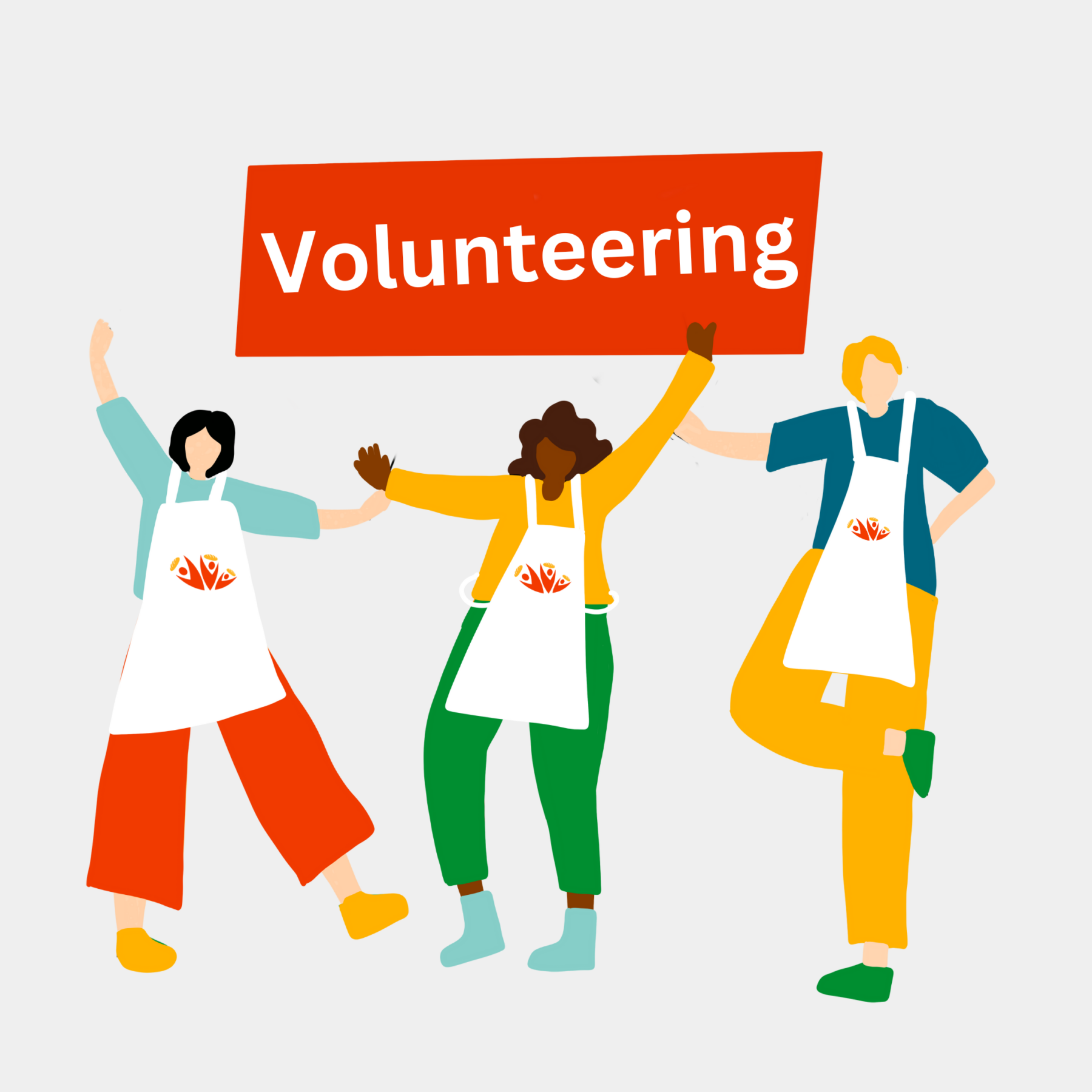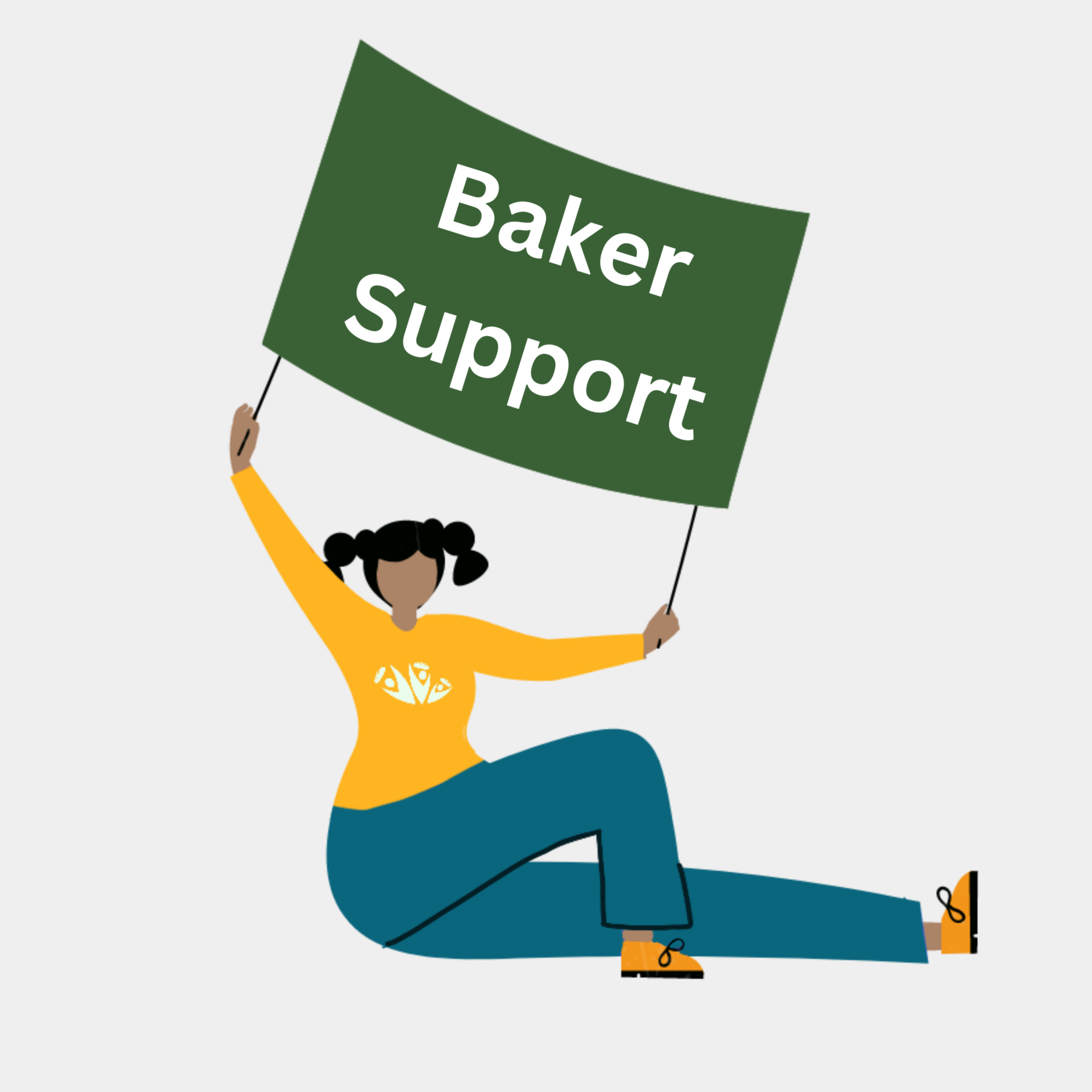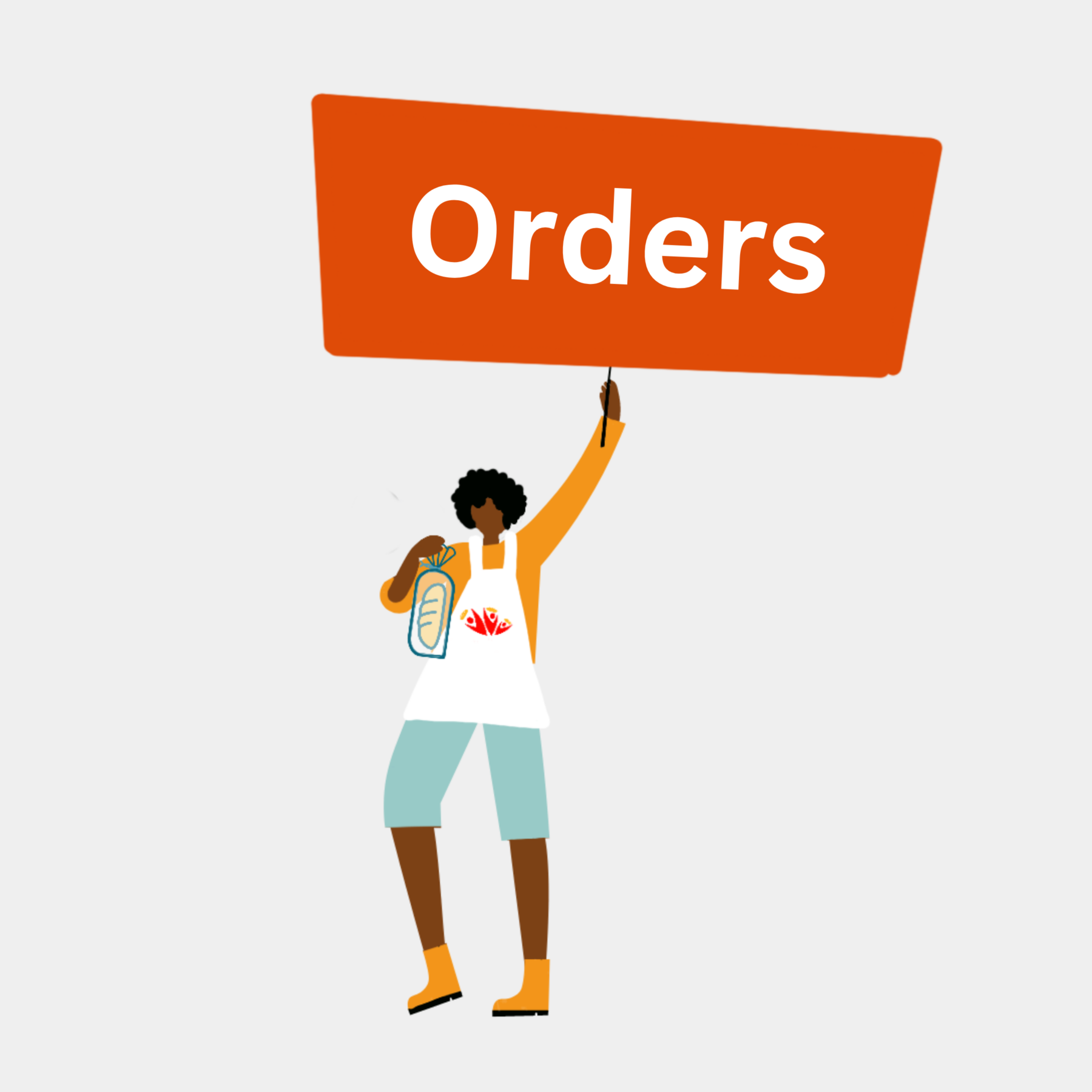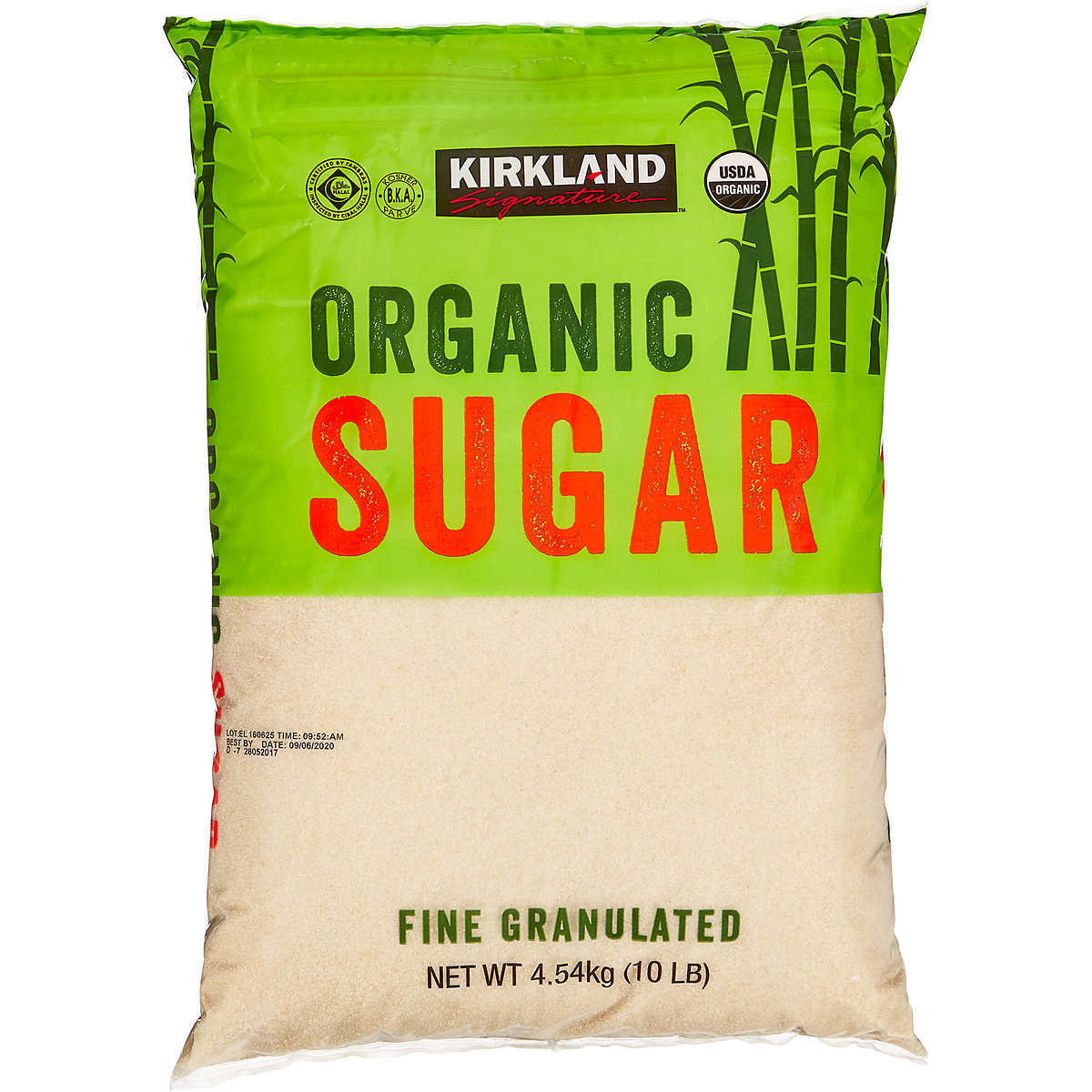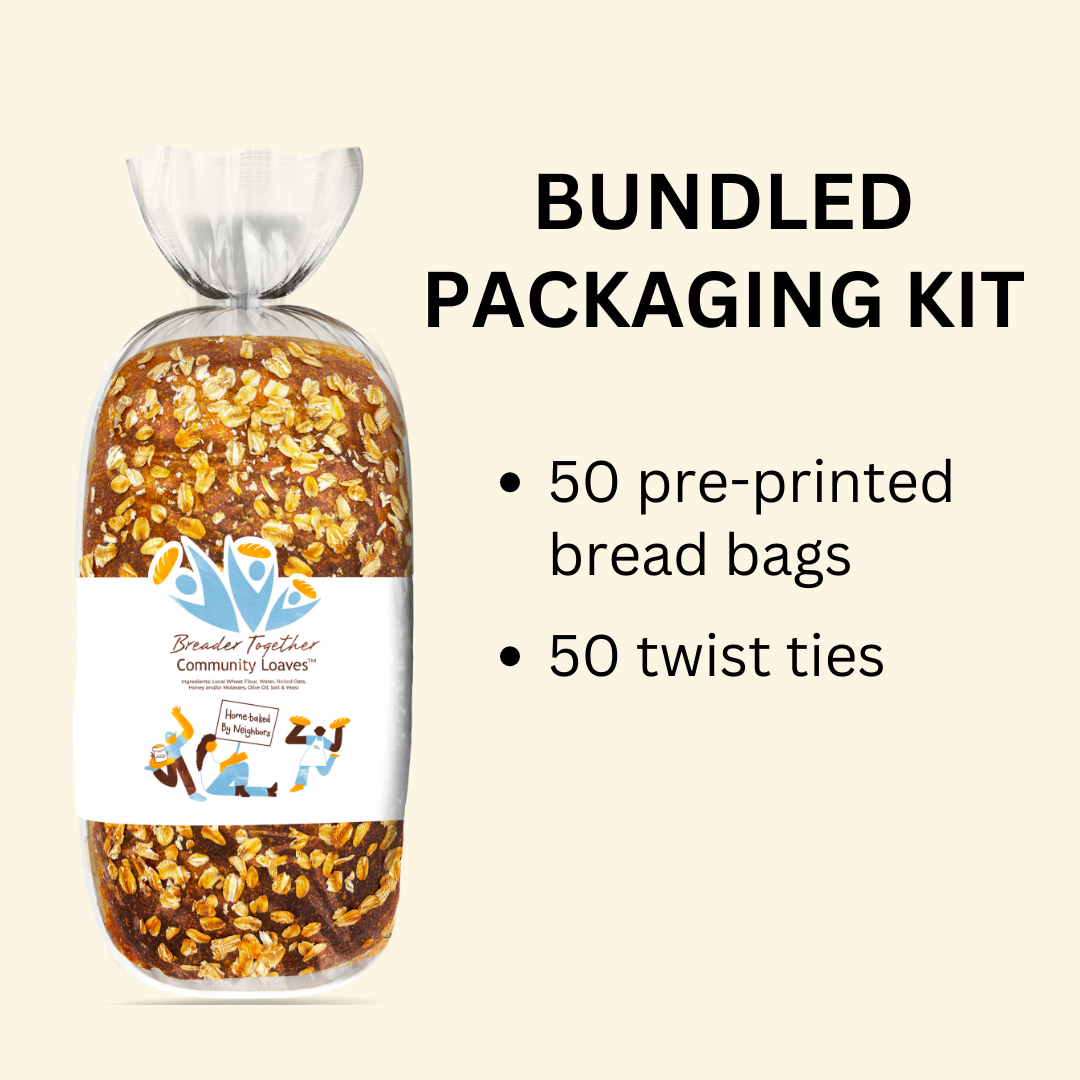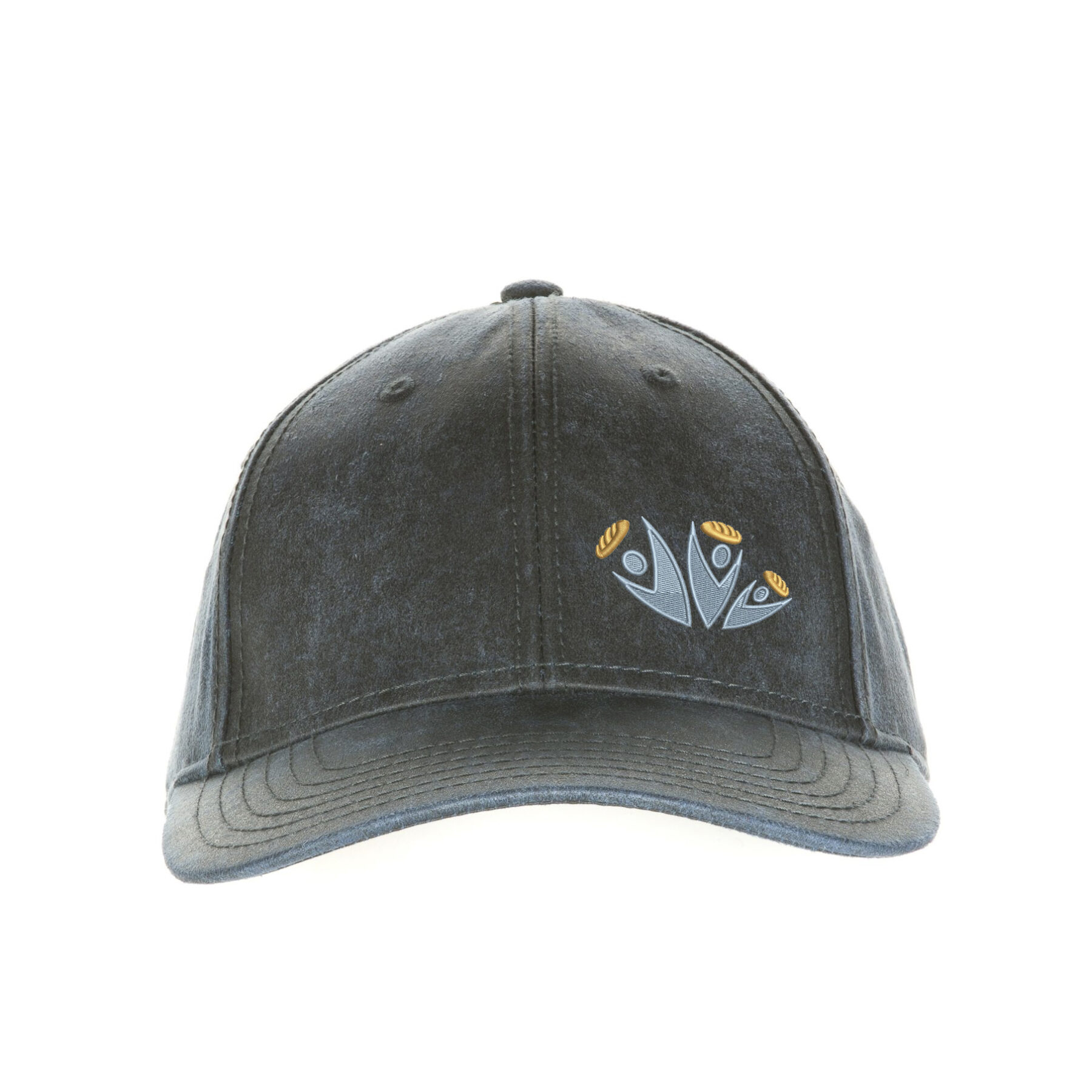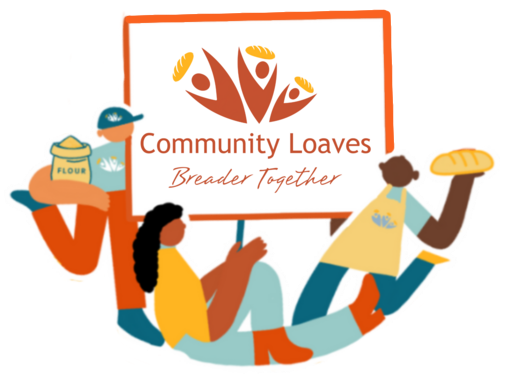Advanced-Bread (4)
Cairnspring Mills recently (early summer 2023) modified their Trailblazer flour which is used by our greater Seattle area bakers to a blend. This blend doesn’t have the same enzymatic activity as the previous version. As a result, we recommend adding 2g – 3g of diastatic malt per loaf to the autolyse step.
Below is the email sent to our bakers on Saturday, July 22nd.
This email is an update on a “rising” issue many are experiencing, including myself, with our bread bakes over the past 3-5 doughnations.
I think we’ve finally cracked the code. It seems to result from the shift in the Trailblazer flour, which is now a blend of wheat vs a single varietal of Yecora Rojo. This new blended TB flour has a higher falling number (FN), one of the metrics flour manufacturers often test for future bread performance. The WSU bread lab has a machine that runs the Hagburg Falling Number test.
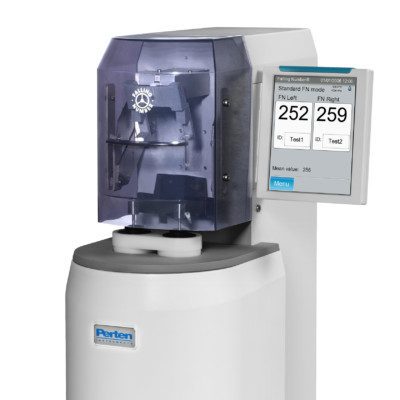
The machine at the lab, looks roughly like the above. It is used to measure the enzyme activity in flour. The FN (Falling Number) of flour is related to the amount and activity of cereal enzyme α-amylase, which is present in wheat after harvesting.
The FN is the time in seconds required for a device to fall a measured distance through a hot flour/water mixture while heat is applied. (Literally tracking the speed of a plunger through the slurry.) If the enzymatic activity is high, the starch is rapidly broken down (liquefied) during gelatinization. So then, the device falls through the relatively liquid paste in a short time. A less viscous fluid opposing less resistance to the flow means the FN is low. On the other hand, if the enzyme’s activity is low, it takes longer for the device to cover the distance of its fall. This means the falling number is high. See the Test
Which brings us to our current Trailblazer.
I do not know the exact falling number for our current TB, but it is reportedly HIGH by Mel Darbyshire, executive baker at Grand Central, who purchases silos of the stuff. And in the shop, meaning at Grand Central, they compensate for the higher falling number, lower enzymatic activity by adding diastatic malt. Diastatic malt vs nondiastic malt the first is cured at low heat and still has its enzymatic properties; nondiastic is mostly lovely sugars we like for browning.
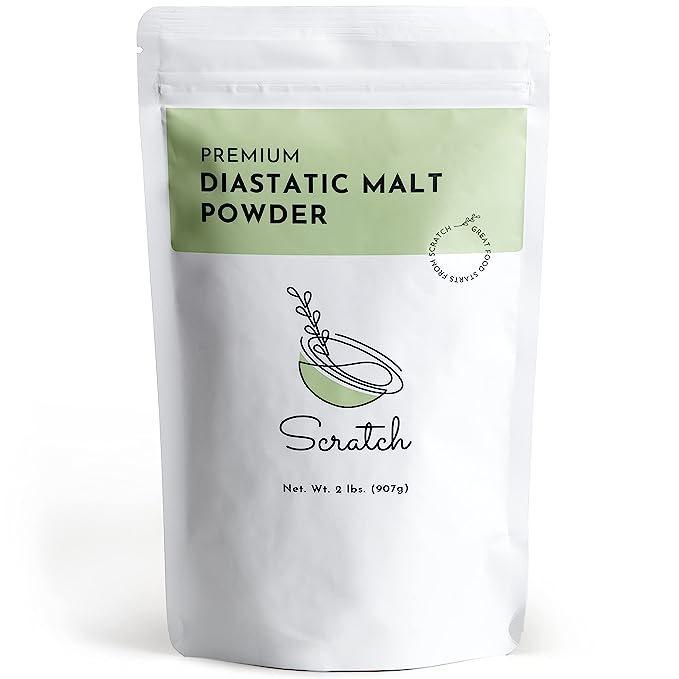
If you are experiencing problems with your loaves, they aren’t rising like they used to, a little Diastatic Malt Powder is your friend. It might be difficult to find at your local store, but you can get it at Amazon, King Arthur, Web Restaurant, and other suppliers.
A little goes a long way. And there is a lot of information on the web. I recommend adding the diastatic malt powder at the beginning of the autolyze phase; you can also add it during the mix if you prefer. How much to add? The range is quite significant: Diastatic malt should be added to the total flour weight in the range of 0.5 to 2%. One loaf is approximately 600g; let’s start at .02%, which would be 3 grams per loaf; making 4 loaves, you’ll want to add 12 grams. Easy math and reasonable assurance for better activity.
There is a lot of information on making your own diastatic malt, for all you DIY’ers. Here is one source for the process: The Fresh Loaf. Another recent piece by talented baker & blogger Maurizio Leo – The Perfect Loaf – What Is Diastatic Malt
I’m so grateful we have a solution to this prickly problem; many of us were wracking our brains about why our near-perfect loaves were acting up. This is part of the issue. In addition, I will put the Organic Expresso to the test. It has a lower falling number and shouldn’t require the diastatic malt. I will also check with Cairnspring to understand whether the current FN issue will be persistent or seasonal. This is freshly milled wheat and flour and part of the ongoing variables that professional bakers manage. We’ve been blessed with so much consistency that it caught us a bit flat-footed, and flat loafed!
Back to FN & Diastatic Malt – Some of you may not have any issues. So this can be a tool in your toolkit down the road. For those of you who are, I’ve shared the beginning of the breadcrumb trail. Some of you will go quite deep down this rabbit hole, and I look forward to hearing from you and your continued learning.
2023-08-16 UPDATE:
Feedback from bakers using the new flour is that the diastatic malt has indeed done the trick. Loaves are back to standard heights.
Hanne, this is a great question and I’m sorry for the delay. We are recommending a small amount of Diastatic Malt to TB even if purchased May 2023. It shouldn’t hurt and it might help if it is the “blended” version. We’re in conversations with Cairnsprings right now to understand the future disposition of the flour. We will keep you posted on those conversations.
Do I need to add diastatic malt to TB received with the May 2023 order? Thanks.
Checked on the shelf life of Diastatic Malt Powder. Dr. Google says it’s about a year, and that can be prolonged by keeping it in the freezer.
We talked about using Diastatic Malt today during the baker debrief. Several bakers reported better success with a smaller amount of diastatic malt 2 to 3 g per loaf you are baking. Give this a try and report back.
Leave a Reply
What is Instant Dry Yeast & How Does It Differ From Active Yeast?
Instant yeast is a dry yeast that comes in smaller granules than active dry yeast, absorbs liquid rapidly, and does not need to be rehydrated or proofed before being mixed into flour. Active dry and instant yeasts can be substituted for one another at a 1:1 ratio. Active dry yeast will take about 15 to 20 minutes longer to rise than instant yeast. Professional bakers enjoy the ease of “instant” yeast, which can be added directly to your mix without “proofing.” Active yeast granules are covered with a small coating that “dissolves” when activated by warm water.
Storing Yeast
You can store an unopened, airtight package of yeast in your pantry for up to two years (but be sure to check the best by or expiration date). Once opened, keep it in the freezer for up to six months or the refrigerator for up to four months. These are simple guidelines and nothing magical in the timeframes. Bakers have kept yeast in the freezer for up to a year without difficulty. But you don’t have to guess. A simple test will tell you if your yeast is still viable.
Is My Yeast Still Viable?
If you suspect that your yeast might be past its prime, you can easily check this out: you’re going to “Proof” the yeast. Follow these instructions:
1. Place some warm water in a cup, say 1/4 cup. Aim for around 100–110 degrees Fahrenheit. Avoid going above 120 degrees, as you’ll begin to damage the yeast at this point. At 140 degrees, you’ll kill the yeast.
2. Mix in yeast (2 1/4 tsp) and sugar (1 tsp) to the warm water. Give a little stir, a small whisk is helpful; this “action” agitates and helps the yeast react. Leave the mixture for 10 minutes. Upon return, if you have a foamy and creamy looking concoction on top, your yeast is still active and good to go (see image below).

Resources: Masterclass, FoodNetwork, The Spruce Eats
Need yeast? Order from our Flour Fundraiser Store!
Leave a Reply
Shoot, your schedule suddenly opened up and you could have baked bread! You still can!
All our loaves begin with a pre-ferment. Typically, an 8-10 hour pre-game element brings delicious flavor to our loaves. But, if you didn’t plan to bake bread, is there a way to complete a one-day process? Yes, our modern formula uses a poolish, vs. a levain (sourdough). A poolish is simply a preferment made with flour, water, and conventional yeast. And, if you are in a pinch for time, as in you want to do a same-day bake, you can simply double the yeast in the pre-ferment.
Come Again: Simply follow the instructions on the formula/recipe for the poolish but double the yeast. That’s it. The same day, pre-ferment will be ready to go in 4 hours.
Fresh whole grain bread, start to finish, in a day!
Leave a Reply
Already Volunteering (6)
One of the best things about Community Loaves is that moving to a new neighborhood doesn’t mean you have to give up baking and donating.
When you started the program, you created a volunteer profile and selected your hub. Now that you’ve moved, you’ll probably want to change your hub to one that is closer to your new residence. Here’s what you need to do….
1. Click on the yellow profile button on your volunteer Dashboard.

2. Scroll down about 1/3 – you’ll see “Change Hub”. Click to edit.
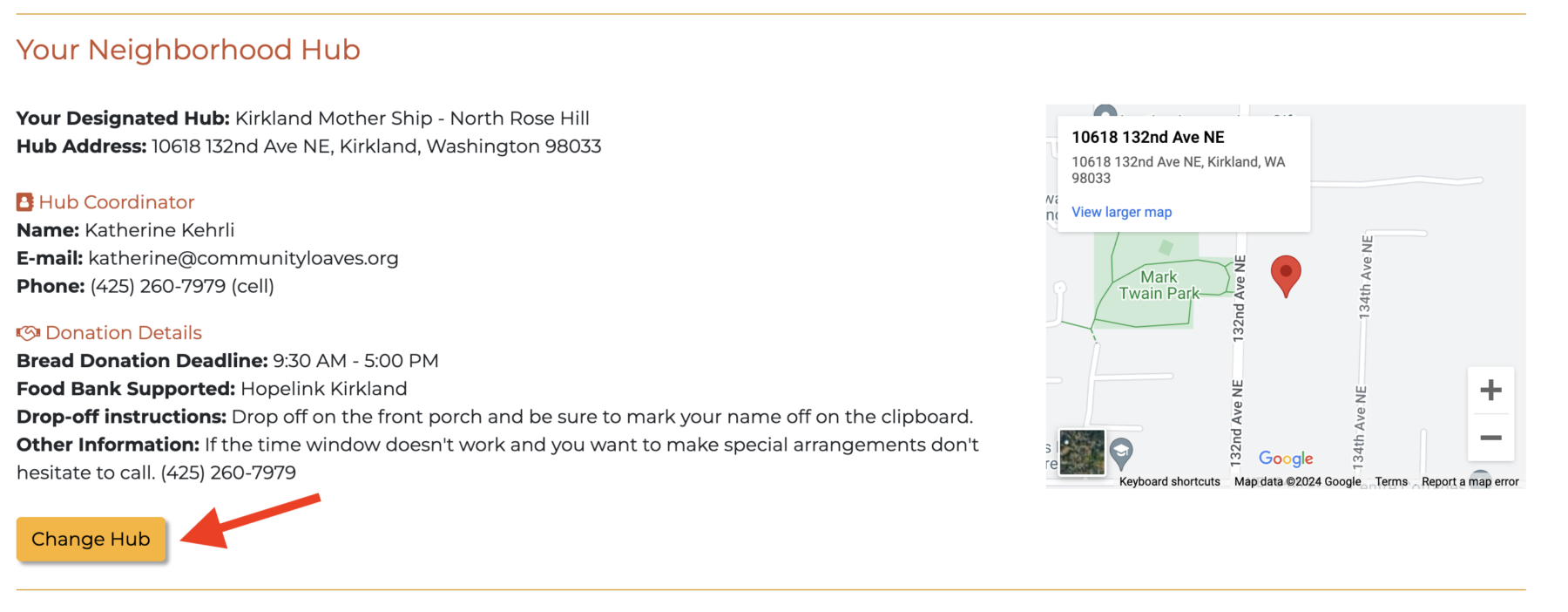
3. Scroll down, type in your zip code and select the hub closest to your new home. Don’t forget to hit “Submit” at the bottom.

4. That’s it. Now you’re part of a new hub and they’ll be expecting you next donation Sunday!
Leave a Reply
Yeast Doesn’t Live Forever
If you suspect that your yeast might be past its prime, you can easily check this out: you’re going to “Proof” the yeast. Follow these instructions:
1. Place some warm water in a cup, say 1/4 cup. Aim for around 100–110 degrees Fahrenheit. Avoid going above 120 degrees, as you’ll begin to damage the yeast at this point. At 140 degrees, you’ll kill the yeast.
2. Mix in yeast (2 1/4 tsp) and sugar (1 tsp) to the warm water. Give a little stir, a small whisk is helpful; this “action” agitates and helps the yeast react. Leave the mixture for 10 minutes. Upon return, if you have a foamy and creamy looking concoction on top, your yeast is still active and good to go (see picture below).

Resources: Masterclass, FoodNetwork, The Spruce Eats
Need yeast? Order from our Flour Fundraiser Store!
Leave a Reply
You may run into a challenge making a donation from outside the US. This happened to our Canadian neighbors who were donating in memory of one of our volunteer bakers who lost her battle with cancer.
If you are interested in donating to Community Loaves and run into difficulty during the check-out process, please attempt the following steps:
- Use your normal billing address
- Check the “Use a different shipping address box” located to the right of the screen.
- Enter our Community Loaves address as the shipping address. Community Loaves, 8730 122nd Ave NE, Kirkland, WA 98033
The image below shows a completed form.
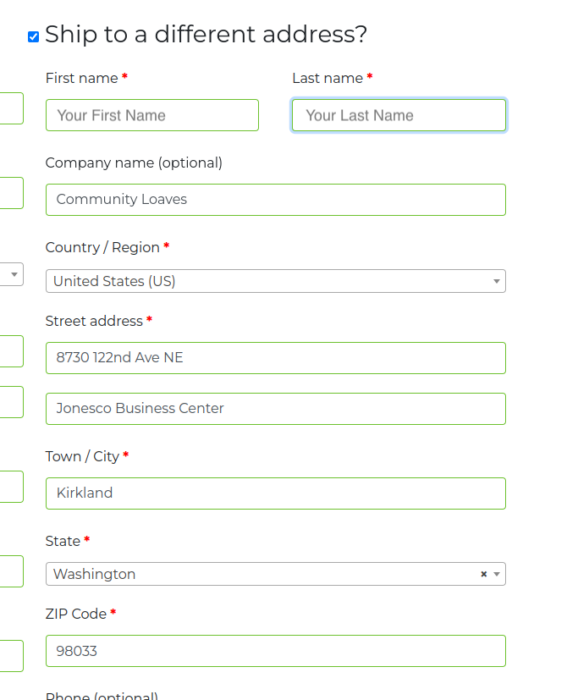
If you are still encountering issues, please contact us directly at info@communityloaves.org.
Thank you in advance for considering making a contribution to Community Loaves!
If you want to view your previous Flour Fundraiser orders, it’s very easy to do so! Simply follow the steps below:
Step 1: On your Dashboard, click on Profile
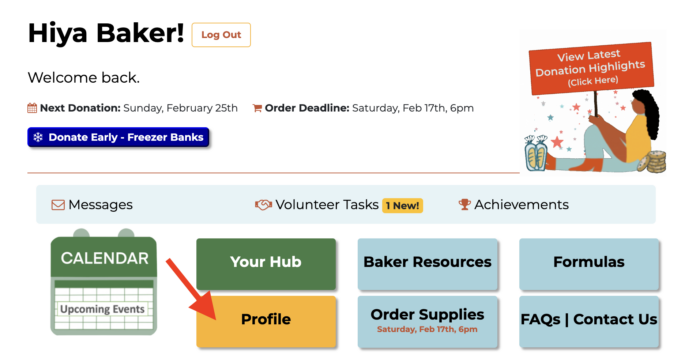
Step 2: Scroll down to the bottom of the page, and you’ll see the Order History Section. Click “View” on the line of the order you’d like to see

Step 4: Voila! There it is.
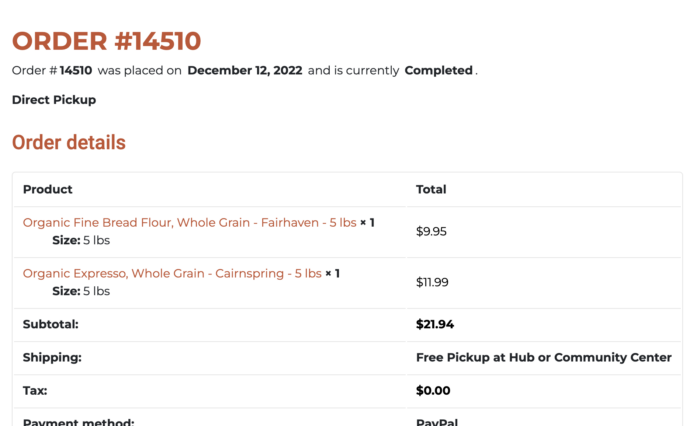
Have any questions? Please reach out to bakersupport@communityloaves.org.
Leave a Reply
Although we like to think once a baker, always a a baker, there are times when an individual would like to end their relationship with the program. If you would your volunteer profile deleted, please send an email to bakersupport@communityloaves.org.
Adding your picture or avatar to your profile is a great way to deepen the “community” at Community Loaves. It is a great way for our hub leaders and hub members to match a face with a name as we do this great work together. It is quick and easy!
Step 1 – Login: Login to your Community Loaves account on the CL Website.
Step 2 – Click Dashboard
Step 3 – Select the yellow Profile button
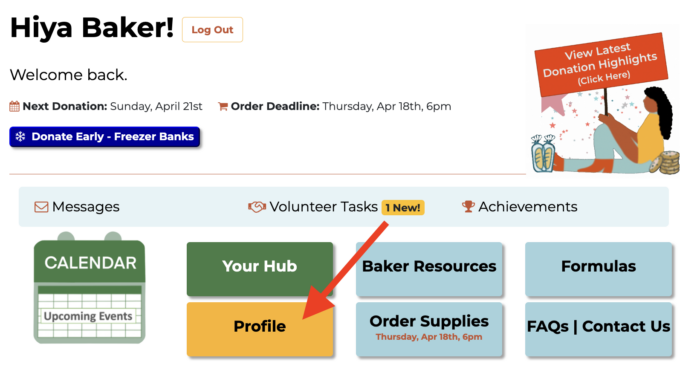
Step 4 – Click on Change Photo

Step 5 – Click the Choose File button to upload an image you have on your computer.

Step 6 – Then select an image (must be .jpg or .png) from your computer and select open. Select an image type .jpg or .png from your computer and select “Open”

Step 7 – You will be able to see a preview of the image. Click “Update Profile” to save your new profile image. Then you can click “Back” to see your new profile photo in use on your baker dashboard.

Step 8 – If you are updating your profile instead of adding a photo for the first time, you will see your existing picture and the option to remove it. Remove the photo and then choose a new file to upload.
Leave a Reply
Baker Badges (1)
Community Loaves baker badges are a way for us to have some fun and acknowledge the tremendous gifts of our volunteer bakers. Our bakers bake from the heart and badges are not really required, still we can’t help but have a little fun and provide a small token to represent the considerable accomplishments each baker makes.
You can see all your earned badges on your badge page. Click on “Achievements” on your dashboard to get to your page. Don’t see it? It is on the blue shaded bar after you log in. It looks like this:

Definitely take time to review what you’ve earned. We’re a small team putting this together, and we’re constantly mending the inevitable coding chinks. Let us know if you’re missing a badge, and even better recommend a badge you think folks would enjoy!
Note: Anniversary badges are calculated from the date of your first donation (not the date you joined the organization).
Leave a Reply
Baker Questions - Bread (4)
So many bakers watching the bread tutorial videos have asked, where can I find those large bowl covers.
Aren’t they great?!
I purchased these through Amazon. They are part of a set, containing multiple sizes. The largest size is great. I’ve put these covers to use for 3 years how and they are still going strong. Simply wash after use and then put back in the drawer.
Here is a link to them on Amazon: REUSABLE ELASTIC FOOD STORAGE BOWL COVERS
Let us know if you have any questions or an even better source!
Bake a quantity of loaves that fits your equipment or physical capacity. The standard recommendation is four loaves: three to donate and one for you and your family to enjoy.
But that might not work for your size mixer, kitchen, or maybe you can make more. Make the batch size that works for you and please keep a loaf to nourish you and your family.
Leave a Reply
Baking (2)
So many bakers watching the bread tutorial videos have asked, where can I find those large bowl covers.
Aren’t they great?!
I purchased these through Amazon. They are part of a set, containing multiple sizes. The largest size is great. I’ve put these covers to use for 3 years how and they are still going strong. Simply wash after use and then put back in the drawer.
Here is a link to them on Amazon: REUSABLE ELASTIC FOOD STORAGE BOWL COVERS
Let us know if you have any questions or an even better source!
The great thing about Community Loaves is that you can literally bake whenever it works for your personal schedule, as long as you have access to a freezer.
However, if you don’t have access to a freezer or freezer bank, then you are a Saturday baker. You’ll want to bake on Saturday, package the items on Sunday (which provides plenty of time for loaves and cookies to cool), and then transport them to your designated hub.
Otherwise, you can bake any day of the week that suits your schedule. You’ll still package these beauties up the next day after they’ve had plenty of time to cool (see our Packaging and Freezing guidelines). Then pop the packaged items into your freezer or get them to a freezer bank. What’s a freezer bank? Learn more here.
Leave a Reply
Delegate Duties (2)
Hub Leaders can select one or more hub members to become Hub Delegates. This delegate role gives another person (or people) all the hub leader tools, so that you have a back up in case of travel, emergency, illness, etc.
Click the Delegate Duties button, and then use the drop down menu beside the name of the baker(s) to give them the “Delegate” role. (see below)
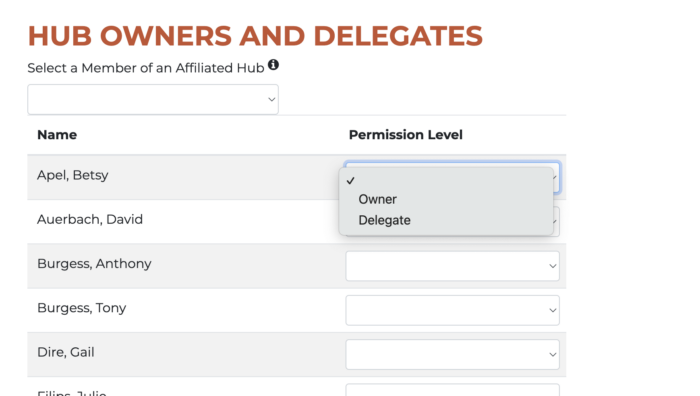
If you have very small hub and need a larger group of volunteers to pull from, you are able to select a member from an affiliate hub to become a delegate of your hub. Use the drop down menu under “Select a Member of an Affiliated Hub” and select a name. They will then be added to your list of Hub members, and you can change their role. (see below)
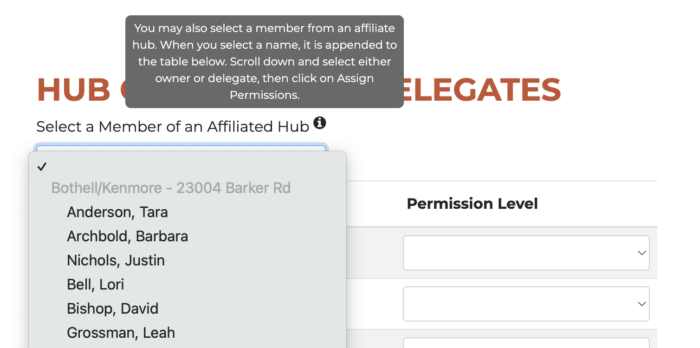
Do you currently have a hub delegate? How do you like to utilize their help? Have anything to share with us about delegating duties? Please do so in the comments below.
Leave a Reply
Delegates can do more than just help you out in a pinch or when you’re on vacation. Once you’ve assigned someone the role of “Delegate,” they’ll have access to all of the same tools that you do as a hub leader.
Examples of tasks you might hand off to a delegate:
Maybe you don’t mind being a drop off spot for Donation Sunday, but don’t have the bandwidth for a delivery trip to the food bank on Monday. Perhaps there’s a hub member to whom you could delegate this task, and who would love to be that link in the donation cycle.
You can also have a delegate help you be a cheerleader for you hub and send out communications a few times a month to your bakers:
- Congratulation cards in our messaging system for baker anniversaries and new badges earned
- Donation follow up emails to thank your bakers for their efforts
Don’t be shy! This organization is full of incredible volunteers who love to lend a hand to help make this machine run smoothly. If you need help, or would like to share the load, ask a delegate!
You may also refer to our “Volunteer Tasks” FAQ to learn more about getting help with one-off tasks.
Leave a Reply
Donation Check In (7)
Each Donation Sunday, we ask that hub leaders submit their hub’s donation totals by 8pm so our automated donation-tallying wizards can do their magic behind the scenes. The Donation Check-In button, located in your hub leader tool kit, will take you to the page where you can complete this important process.
You’ll need to print the check-in list on Sunday morning, and then return to the Check-In page that evening to record the final numbers.
Once the numbers have been submitted, the hub leader and all delegates receive an email confirmation of the submission. There is a link in the email if updates need to the record need to be made.
Watch the following video to following along, and see the process explained step-by-step below.
Questions? Tips? Share in the comments!
Leave a Reply
On Donation Sunday, click on the Donation Check-In button and then using the “Print Check-In Sheet Button” print the list of all your bakers. The list will include those who’ve “pre-checked” at the top and all the other members at the bottom. Sometimes folks forget to pre-check. The button looks like this:

Place the printout on your hub clipboard and leave by your drop off door. Volunteers should initial and update their donation amounts directly on the clipboard.
Leave a Reply
At the end of the collection period (any time before 8pm Sunday), you’ll return to your computer to record your final counts. Click back on the “Donation Check In” button and this time, click on “Record Final Counts”.

You do not have to fill in zeroes for bakers. Just record actuals. Example: If Katherine pre-registered 10 loaves but showed up with 12, then refresh the information with the number “12” in the loaves column. You have a loaves and two cookies columns, and you want to be mindful that you’re updating the correct column.
Last but not least….Once you’ve updated the numbers, you need to scroll to the bottom and hit Submit Final Counts! 
Leave a Reply
If you need additional help with Donation Check-In, please comment below or reach out to breadertogether@communityloaves.org and we will get you up and running.
To set up a “Delegate” to help you with any part of the donation process (for example, if you are going to be out of town, or are ill) please advance to the FAQ on setting up Delegate Duties.
In addition, please refer to the “Volunteer Tasks” FAQ to learn about engaging your hub members for help when you need it!
Leave a Reply
As a hub leader, one of the most important jobs you have is being a cheerleader for your bakers. Engaging with bakers and letting them know how appreciated and impactful their donations are is truly the best way to keep them baking.
A post Donation Day recap email is a great way to regularly engage with your hub. Every post-Donation day Monday morning, we send out an email recap with your hub’s donation details and highlights – how many loaves and cookies were donated, who has earned new badges, and who has met new milestones. You can also find those stats through the donation record (located in Donation Reports, in the Special Admin Section of your Dashboard). We recommend sending these emails out to all bakers in your hub, active and inactive, as these can be highly motivating emails and might lure back bakers who have fallen out of the habit of baking regularly.
* As a reminder, all emails and communications should be sent through the Community Loaves Email tool or messaging system. *
Leave a Reply
Things happen. Counts can sometimes be a little off, a donation amount ascribed to a different person, loaves or cookies spontaneously showing up at your door. If you catch this early enough, before 8:00 am on the Monday following donation Day, you can simply resubmit your final counts.
But suppose you need to check on or modify a previous donation record, not the one from last night. You can easily do that from your hub toolkit.
Here are the steps!
- Click on Donation Check-In – the first green box on your dashboard.

- On the right you’ll see a date select box. Choose the donation date in question to view the donation record.

- Validate that the change is needed and then send an email to bakersupport@communityloaves.org. We will need the name of the baker, the number of loaves and/or cookies and the variety of the energy cookie – Blueberry/Pecan or Chocolate Cherry. The change will be made within 3 business days.
Coming soon: You’ll see your hub members and donation numbers associated with that date. You can easily make the change the same way you would if were submitting your final counts. Just amend the specific baker, input the correct number and click resubmit.
Who’s this baker?
Occasionally someone you don’t recognize might be dropping bread or cookies at your door. All volunteer bakers are trained that they can drop off their donation wherever convenient. Although not common, you may receive the occasional donation from a hub member not registered to your hub. They will have written their name on the clipboard, and you can search for them under “Add Other Baker” and then record their donation. Super easy.
You can check this rogue donation in easily on the hub check-in page with the rest of your hub members’ donations.
- Scroll to the bottom of the Donation Check-in page.
- Click the yellow “Add Other Baker” button.

- Search the name of the baker.

- Select baker and then enter the donation amounts in the appropriate boxes.

- You can click the “Add Other Baker” button again if you have multiple bakers to add.
- Click “Submit Final Counts” to save these edits (these images show updating a past donation, so the button says “Submit Edits” instead).
Leave a Reply
Edit Hub (1)
Email (3)
It is a program requirement for all email and communication to originate from Community Loaves email or messaging tools. Unlike more sophisticated organizations, we don’t yet have a broad set of permissions that allow our volunteers to opt in and out of our communications. Please be sure to keep any and all communication to our volunteers related to our program operations!
As a hub leader, one of the most important jobs you have is being a cheerleader for your bakers. We expect that you will communicate with your hub no less than twice per month, and hopefully more! Engaging with bakers and letting them know how appreciated and impactful their donations are is truly the best way to keep them baking!
Please lean into focusing your communication on the impact and results of the most recent donation, and/or celebrating your bakers and their individual achievements. You can find those stats through the donation record (found in Donation Reports, in the Special Admin Section of your Dashboard). These types of emails should be sent to all bakers, even those marked as “inactive”, as they can be quite impactful and encourage a baker’s return to donating.
Of course, some of your communications will be more tactical; these messages should only be sent to “active” bakers.
FYI: “Active” status is applied to volunteers who have just joined Community Loaves and/or have made a baking donation within the past six months. After six months of no baking donations, a volunteer is moved to an “Inactive” status. Sometimes we encounter errors with these designations, so please reach out if you have a baker who has the wrong status.
Leave a Reply
- Click on the Email button in your Hub Leader Toolkit (see image above)
- Select your hub from the drop down menu.
- In the “Send to” field, select your intended audience.
- You may add any other email addresses in the Additional Recipients field.
- You may also filter recipients by Hub role (All Members or Managers & Delegates), affiliate Hubs, and by name.
- Type your Subject.
- Write your email! Include any photos or other media you like.
- Send immediately, or save a draft for later.
1. Click on the Email button in your Hub Leader Toolkit.
2. To email the whole hub, select Active Hub Members and/or Inactive Hub Members (depending on the content, you may want to include Inactive Members to let them see the impact of our baking efforts; maybe it will encourage their return to baking!).
3. To include anyone who might not be a member of our organization, you can click on “Additional Recipients” and type their email address in (Ex.: Your spouse helps with flour distribution, and you want them to have all the details, but they don’t have their own account with CL).
4. To send to just specific hub members, click the “Select Individuals” Box.

4a. Click on the names you want the email sent to and then click “Done.” The names will populate in the “Individuals” box.
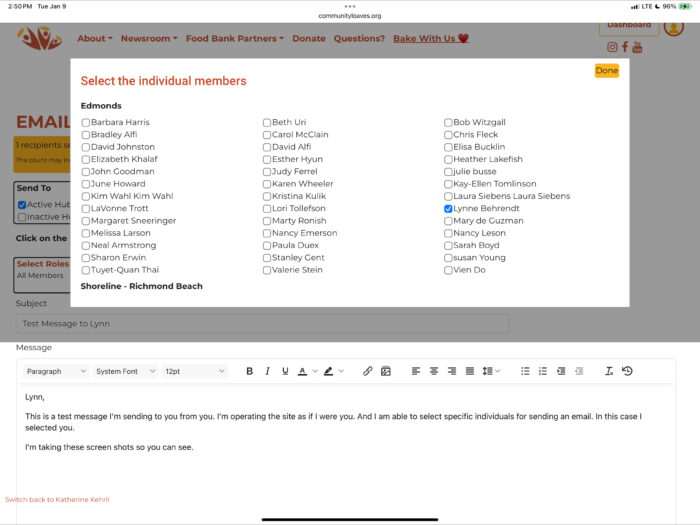
5. Type your message and then click “Email Hub Contacts.”
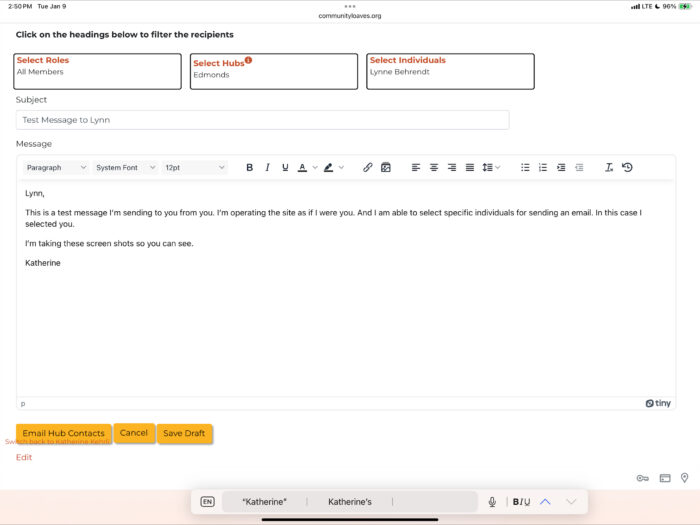
6. You need to approve the message by checking the little box next to “Approved.” Click “Send” – and voila! Success.

Leave a Reply
Everything Else (4)
On your Dashboard, you’ll find a Calendar icon (see below). We list all of our program events on this calendar, from delivery days, to donation days, to food bank tours, and so on.

If you hover over an event on the calendar, you will see a pop-up box with more event info. Clicking on an event will take you to its full information page, with its location, time, and volunteer sign-up link (if applicable) listed.
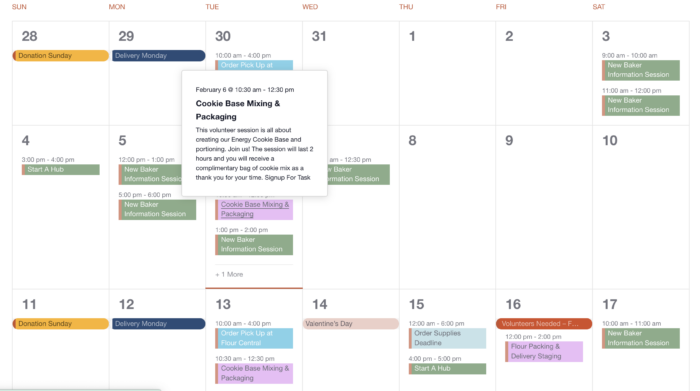
Leave a Reply
What? You’ve not going to be home Sunday for the bread and energy cookie donation? OK, truly, no problem! Of course, it is impossible to be around for every Donation Sunday. Just use your hub tools to keep bakers informed.
For example, you will want to make sure that bakers know you’ll be away, use the Email Tool. You’ll want to make sure you’ve got a volunteer to take the donation to the food bank, use the Volunteer Tasks tool to recruit. And, you’ll want to update the address and any instructions on your Edit Hub tool.
Changing the hub address is a temporary and handy modification. When a baker pre-checks their donation, the email confirmation they receive automatically includes the directions to the temporary location and any special instructions. When you return from the tropics, you can go back to the Edit Hub tool and revise the hub address.
If you have questions on this, please reach out.
Finally, if you are also a truck stop manager and we need to make changes to the delivery drop, please notify Delivery@communityloaves.org. This is really important for smooth operations. That address shows on their supply order confirmations, as well any emailed and/or texted reminder notifications. We want our bakers to go to the correct address to pick up their supplies.
Leave a Reply
Although we like to think once a baker, always a a baker, there are times when an individual would like to end their relationship with the program. If you would your volunteer profile deleted, please send an email to bakersupport@communityloaves.org.
You’ll see that volunteers are listed in your hub as either Active or Inactive. What does this mean?
All bakers who’ve joined Community Loaves and/or donated in the most recent 6 months automatically have an Active status. If, however, they do not donate for six months, their status is changed to Inactive.
Why? Early in our formation, it was frustrating for hub leaders to see all these bakers on their roster who rarely, if ever, showed up. Creating an inactive status allowed us to differentiate bakers who seemed to be baking and donating from those who seemed to have fallen to the wayside or simply taking a break.
Although their status is inactive, that is a behind-the-scenes label only. Semi-regular communication will keep them in the loop on your hub activities and may motivate them to resume baking and donating. The moment they do, their status will immediately be updated to Active.
Again, this is a status change only; the baker can still login to their account, pull their doughnation statements, update their hub, order supplies, really all functions. This past year, some bakers returned to bake and donate the Holiday Cookie after a long break. When they do, their status updates to Active.
Please feel free to let us know in the feedback section below if you have any questions, comments, or considerations on this program element.
Everything Else (4)
Heading out of town, want to drop your loaves off early? You don’t have to miss a donation, you can bake ahead and take your items to your nearest freezer bank.
A freezer bank is an independent donation location; it is like a hub, and sometimes it is located at your hub. The difference is unlike your hub check-in, where the donations are organized for Sunday. Freezer banks can take donations at any time, well, within reason, that is. Then the freezer bank manager makes sure that your loaves and/or cookies are transferred to the food bank for the next donation date.
You’ll find the Freezer Bank opportunity in the same location as your regular Donation Check-In.
1. Click the Loaves/Cookies Button

2. Select “Freezer Bank”

3. Click the down arrow to reveal the location opportunities. We are adding more and more freezer banks as the weeks and months progress
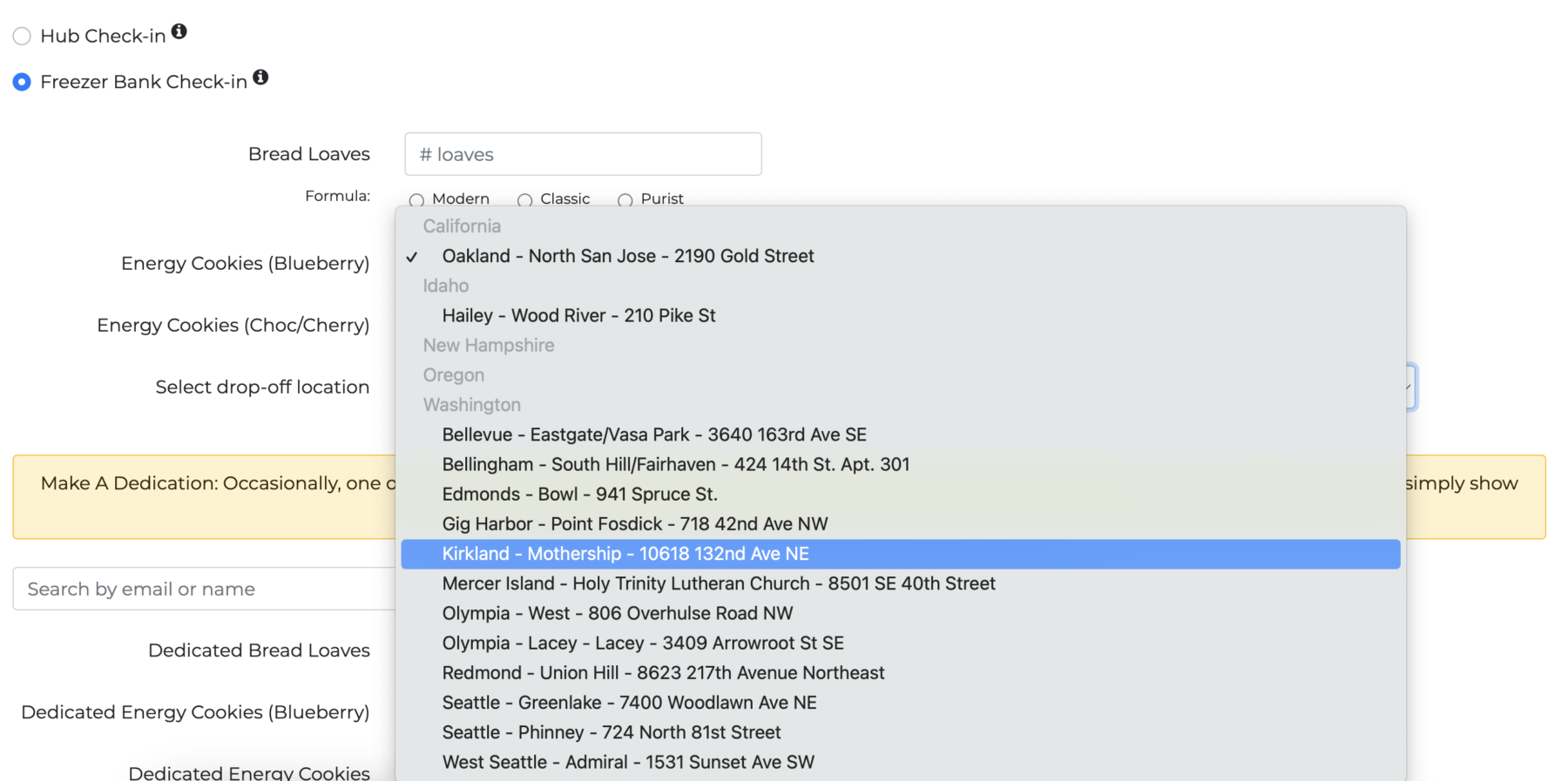
After checking in your items, your confirmation message will provide the details for reaching out to the freezer bank manager. You can confirm via text, email or phone that you’ll be bringing by your items for cold storage. Then head off to the Bahamas with peace of mind and the positive vibes of a donation that is in the bank!
Have an extra freezer? Want to become a drop point for donations? Freezer banks allow bakers to drop off their donations at times outside of the usual Sunday donation day: easier for those with unconventional schedules, or when vacations or other responsibilities interfere with a Sunday drop off.
As the freezer bank manager, you will be responsible for making sure that the loaves and cookies donated to your freezer are transferred to the food bank for the next donation date. This might mean bringing them to your hub along with your own donations on donation Sunday, or it might be that you drop them off yourself at the food bank Monday.
Still interested? Send us a message and we’ll get back to you soon!
To support our baking efforts, we run a monthly flour fundraiser. This fundraiser gives our volunteer bakers a lovely discount on high-quality professional flours and allows our 501c3 non-profit organization to thrive! Like a sourdough starter, regular “feedings” help to fund our growth and development. Registered volunteers can easily access our online shop for the purchase of essential supplies for the items we bake and donate to our food bank partners.
But, if you aren’t a registered volunteer, and are concerned about having time to bake with us, you can support the mission of Community Loaves and your baking habit at the same time. Every Tuesday from 10:00 – 4:00 pm, our Flour Store is open for drop-in visits. We’re located at 8730 122nd Ave NE, Kirkland. Here, at Flour Central, you can purchase freshly milled flours from the Skagit at a discount to retail, as well as a few specialty flours typically available to professional bakers only. If you have questions on availability, send us an email at bakersupport@communityloaves.org.
In all cases, we strive to keep this program accessible and affordable to the best of our ability while ensuring we can support our food banks for years to come.
Leave a Reply
Adding your picture or avatar to your profile is a great way to deepen the “community” at Community Loaves. It is a great way for our hub leaders and hub members to match a face with a name as we do this great work together. It is quick and easy!
Step 1 – Login: Login to your Community Loaves account on the CL Website.
Step 2 – Click Dashboard
Step 3 – Select the yellow Profile button

Step 4 – Click on Change Photo

Step 5 – Click the Choose File button to upload an image you have on your computer.

Step 6 – Then select an image (must be .jpg or .png) from your computer and select open. Select an image type .jpg or .png from your computer and select “Open”

Step 7 – You will be able to see a preview of the image. Click “Update Profile” to save your new profile image. Then you can click “Back” to see your new profile photo in use on your baker dashboard.

Step 8 – If you are updating your profile instead of adding a photo for the first time, you will see your existing picture and the option to remove it. Remove the photo and then choose a new file to upload.
Leave a Reply
Everything Else (11)
One of our favorite questions! Yes, we do provide these hours. You will find them on your volunteer profile page. You receive hours for baking and donating loaves and cookies, packing flour, packing cookie mix, serving as a hub leader, driving and/or organizing supplies, and helping out your hub leader. Just about every aspect of the program acknowledges your dedication with a volunteer time credit!
To find, view, and print your “statement”:
- Login to your volunteer dashboard.
- Click the yellow “Profile” button.
- Scroll down, you’ll see some options for viewing your statement. This year, last year and then click to view as a pdf. You can also see all of this year’s donations itemized right ther on the profile page.
- Donations are calculated as follows – 6 hours for every combination of 3-4 loaves of bread donated and 3 hours for every batch of cookies. These are based on existing averages.
- Note our EIN number is on the statement to make it easy for you when you file your annual tax return.
We track these efforts intentionally, young bakers can earn Community Service credit, and working bakers can submit their time with their companies for corporate matching. Those are really valuable dollars for this little non-profit organization.
If you need additional information to complete your submission, please send an email to bakersupport@communityloves.org
Leave a Reply
Heading out of town, want to drop your loaves off early? You don’t have to miss a donation, you can bake ahead and take your items to your nearest freezer bank.
A freezer bank is an independent donation location; it is like a hub, and sometimes it is located at your hub. The difference is unlike your hub check-in, where the donations are organized for Sunday. Freezer banks can take donations at any time, well, within reason, that is. Then the freezer bank manager makes sure that your loaves and/or cookies are transferred to the food bank for the next donation date.
You’ll find the Freezer Bank opportunity in the same location as your regular Donation Check-In.
1. Click the Loaves/Cookies Button

2. Select “Freezer Bank”

3. Click the down arrow to reveal the location opportunities. We are adding more and more freezer banks as the weeks and months progress

After checking in your items, your confirmation message will provide the details for reaching out to the freezer bank manager. You can confirm via text, email or phone that you’ll be bringing by your items for cold storage. Then head off to the Bahamas with peace of mind and the positive vibes of a donation that is in the bank!
We have a new tool that allows you to send a quick note or an animated card to a baker, or your whole hub. SO fun! However, this is different from our email tool, and it looks like this:

Here’s how it can be accessed:
-
- Click “Messages” in the blue bar at the top of your Dashboard. This will take you to the page view seen above. If you have a new message, a notification will show up next to “Messages” (just like you can see “4 New!” next to Volunteer Tasks, below).

2. Click on “View Latest Donation Highlights”
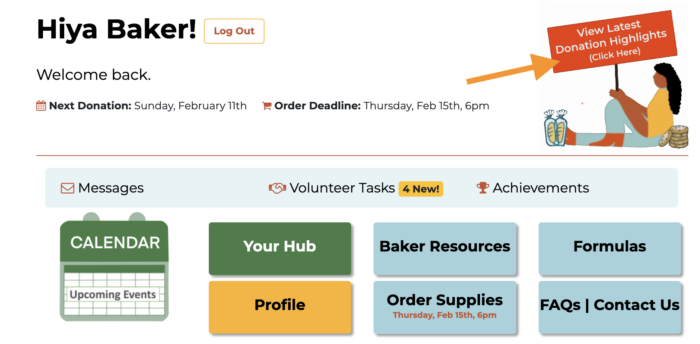
This will take you to the Donation Highlights page, where you can view organization totals, baker anniversaries and badges earned, and hub specific numbers for any donation date you choose from the drop down menu. You can toggle between Organization Totals and View My Hub Only to change what you’re seeing on the page.
Tabs allow you to view the names of bakers who are celebrating anniversaries, or have earned specific badges during the donation date chosen. Click on the green “Say Congratulations” button next to a baker’s name.
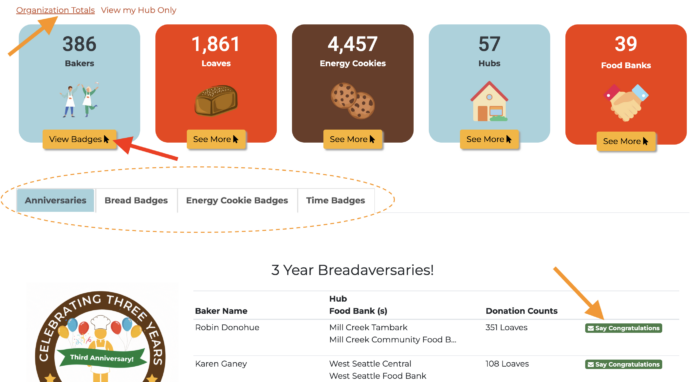
3. Access a list of all your hub members from the Your Hub button located on your main Dashboard.
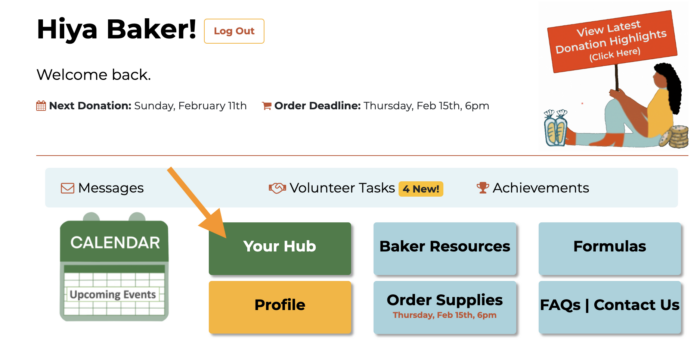
Then scroll down to the grid of friendly faces, and click on the little red envelope icon. This will take you to the messaging tool and you can choose a card to send, or just send a quick note.

Leave a Reply
One of the best things about Community Loaves is that moving to a new neighborhood doesn’t mean you have to give up baking and donating.
When you started the program, you created a volunteer profile and selected your hub. Now that you’ve moved, you’ll probably want to change your hub to one that is closer to your new residence. Here’s what you need to do….
1. Click on the yellow profile button on your volunteer Dashboard.

2. Scroll down about 1/3 – you’ll see “Change Hub”. Click to edit.

3. Scroll down, type in your zip code and select the hub closest to your new home. Don’t forget to hit “Submit” at the bottom.

4. That’s it. Now you’re part of a new hub and they’ll be expecting you next donation Sunday!
Leave a Reply
You may run into a challenge making a donation from outside the US. This happened to our Canadian neighbors who were donating in memory of one of our volunteer bakers who lost her battle with cancer.
If you are interested in donating to Community Loaves and run into difficulty during the check-out process, please attempt the following steps:
- Use your normal billing address
- Check the “Use a different shipping address box” located to the right of the screen.
- Enter our Community Loaves address as the shipping address. Community Loaves, 8730 122nd Ave NE, Kirkland, WA 98033
The image below shows a completed form.

If you are still encountering issues, please contact us directly at info@communityloaves.org.
Thank you in advance for considering making a contribution to Community Loaves!
Have an extra freezer? Want to become a drop point for donations? Freezer banks allow bakers to drop off their donations at times outside of the usual Sunday donation day: easier for those with unconventional schedules, or when vacations or other responsibilities interfere with a Sunday drop off.
As the freezer bank manager, you will be responsible for making sure that the loaves and cookies donated to your freezer are transferred to the food bank for the next donation date. This might mean bringing them to your hub along with your own donations on donation Sunday, or it might be that you drop them off yourself at the food bank Monday.
Still interested? Send us a message and we’ll get back to you soon!
If you want to view your previous Flour Fundraiser orders, it’s very easy to do so! Simply follow the steps below:
Step 1: On your Dashboard, click on Profile

Step 2: Scroll down to the bottom of the page, and you’ll see the Order History Section. Click “View” on the line of the order you’d like to see

Step 4: Voila! There it is.

Have any questions? Please reach out to bakersupport@communityloaves.org.
Leave a Reply
On your Dashboard, you’ll find a Calendar icon (see below). We list all of our program events on this calendar, from delivery days, to donation days, to food bank tours, and so on.

If you hover over an event on the calendar, you will see a pop-up box with more event info. Clicking on an event will take you to its full information page, with its location, time, and volunteer sign-up link (if applicable) listed.

Leave a Reply
The great thing about Community Loaves is that you can literally bake whenever it works for your personal schedule, as long as you have access to a freezer.
However, if you don’t have access to a freezer or freezer bank, then you are a Saturday baker. You’ll want to bake on Saturday, package the items on Sunday (which provides plenty of time for loaves and cookies to cool), and then transport them to your designated hub.
Otherwise, you can bake any day of the week that suits your schedule. You’ll still package these beauties up the next day after they’ve had plenty of time to cool (see our Packaging and Freezing guidelines). Then pop the packaged items into your freezer or get them to a freezer bank. What’s a freezer bank? Learn more here.
Leave a Reply
Although we like to think once a baker, always a a baker, there are times when an individual would like to end their relationship with the program. If you would your volunteer profile deleted, please send an email to bakersupport@communityloaves.org.
The hub leadership was never intended to be a lifetime role. We recognize the time will come when you will be ready or will need to pass the proverbial baguette. The following process will help to guide this effort and create a smooth transition and continuity for our Breader Together efforts.
FYI – It is helpful to transition hubs at specific times of the calendar year when other activities for our non-profit are slower. If you can plan for an August or December transition, that is ideal. Life events don’t always happen at an ideal time, but if we have the luxury of time, August or December are best.
Here are the steps:
- Notify Katherine that you’re looking to find new leadership for the hub.
- Together, you’ll talk through any logical successor candidates, perhaps existing delegates and/or super helpful hub members.
- You’ll agree on a desired timeline and a communication plan to the hub to solicit interest.
- Any interested candidates will need to attend a hub training session. You and Katherine will encourage folks to attend this hub leader training.
- Although only one person can be a hub leader, the opportunity to train multiple people at once helps create a knowledgeable leadership team that can support one another.
- In the unlikely event that nobody emerges able/willing to take on these responsibilities, the hub will be closed, and hub members will be reassigned to the next closest hub.
Please notify Katherine (katherine@communityloaves.org) if you would like to begin the hub transition process.
Leave a Reply
Flour and Ingredient Selection (11)
Cairnspring Mills recently (early summer 2023) modified their Trailblazer flour which is used by our greater Seattle area bakers to a blend. This blend doesn’t have the same enzymatic activity as the previous version. As a result, we recommend adding 2g – 3g of diastatic malt per loaf to the autolyse step.
Below is the email sent to our bakers on Saturday, July 22nd.
This email is an update on a “rising” issue many are experiencing, including myself, with our bread bakes over the past 3-5 doughnations.
I think we’ve finally cracked the code. It seems to result from the shift in the Trailblazer flour, which is now a blend of wheat vs a single varietal of Yecora Rojo. This new blended TB flour has a higher falling number (FN), one of the metrics flour manufacturers often test for future bread performance. The WSU bread lab has a machine that runs the Hagburg Falling Number test.

The machine at the lab, looks roughly like the above. It is used to measure the enzyme activity in flour. The FN (Falling Number) of flour is related to the amount and activity of cereal enzyme α-amylase, which is present in wheat after harvesting.
The FN is the time in seconds required for a device to fall a measured distance through a hot flour/water mixture while heat is applied. (Literally tracking the speed of a plunger through the slurry.) If the enzymatic activity is high, the starch is rapidly broken down (liquefied) during gelatinization. So then, the device falls through the relatively liquid paste in a short time. A less viscous fluid opposing less resistance to the flow means the FN is low. On the other hand, if the enzyme’s activity is low, it takes longer for the device to cover the distance of its fall. This means the falling number is high. See the Test
Which brings us to our current Trailblazer.
I do not know the exact falling number for our current TB, but it is reportedly HIGH by Mel Darbyshire, executive baker at Grand Central, who purchases silos of the stuff. And in the shop, meaning at Grand Central, they compensate for the higher falling number, lower enzymatic activity by adding diastatic malt. Diastatic malt vs nondiastic malt the first is cured at low heat and still has its enzymatic properties; nondiastic is mostly lovely sugars we like for browning.

If you are experiencing problems with your loaves, they aren’t rising like they used to, a little Diastatic Malt Powder is your friend. It might be difficult to find at your local store, but you can get it at Amazon, King Arthur, Web Restaurant, and other suppliers.
A little goes a long way. And there is a lot of information on the web. I recommend adding the diastatic malt powder at the beginning of the autolyze phase; you can also add it during the mix if you prefer. How much to add? The range is quite significant: Diastatic malt should be added to the total flour weight in the range of 0.5 to 2%. One loaf is approximately 600g; let’s start at .02%, which would be 3 grams per loaf; making 4 loaves, you’ll want to add 12 grams. Easy math and reasonable assurance for better activity.
There is a lot of information on making your own diastatic malt, for all you DIY’ers. Here is one source for the process: The Fresh Loaf. Another recent piece by talented baker & blogger Maurizio Leo – The Perfect Loaf – What Is Diastatic Malt
I’m so grateful we have a solution to this prickly problem; many of us were wracking our brains about why our near-perfect loaves were acting up. This is part of the issue. In addition, I will put the Organic Expresso to the test. It has a lower falling number and shouldn’t require the diastatic malt. I will also check with Cairnspring to understand whether the current FN issue will be persistent or seasonal. This is freshly milled wheat and flour and part of the ongoing variables that professional bakers manage. We’ve been blessed with so much consistency that it caught us a bit flat-footed, and flat loafed!
Back to FN & Diastatic Malt – Some of you may not have any issues. So this can be a tool in your toolkit down the road. For those of you who are, I’ve shared the beginning of the breadcrumb trail. Some of you will go quite deep down this rabbit hole, and I look forward to hearing from you and your continued learning.
2023-08-16 UPDATE:
Feedback from bakers using the new flour is that the diastatic malt has indeed done the trick. Loaves are back to standard heights.
Hanne, this is a great question and I’m sorry for the delay. We are recommending a small amount of Diastatic Malt to TB even if purchased May 2023. It shouldn’t hurt and it might help if it is the “blended” version. We’re in conversations with Cairnsprings right now to understand the future disposition of the flour. We will keep you posted on those conversations.
Do I need to add diastatic malt to TB received with the May 2023 order? Thanks.
Checked on the shelf life of Diastatic Malt Powder. Dr. Google says it’s about a year, and that can be prolonged by keeping it in the freezer.
We talked about using Diastatic Malt today during the baker debrief. Several bakers reported better success with a smaller amount of diastatic malt 2 to 3 g per loaf you are baking. Give this a try and report back.
Leave a Reply
To support our baking efforts, we run a monthly flour fundraiser. This fundraiser gives our volunteer bakers a lovely discount on high-quality professional flours and allows our 501c3 non-profit organization to thrive! Like a sourdough starter, regular “feedings” help to fund our growth and development. Check out our offerings and place your order here. You can also find a link to order supplies on your dashboard.
Locally, meaning in the greater Seattle area, we have a delivery service once a month. This takes place roughly the third week of each month. And the dates can be found on our program calendar. In order for our volunteers to have enough time to prepare for each delivery event, we turn the store off three days before we have to pack flour and load the truck. It is a good idea to order your supplies as soon as you know you need them.
We also direct ship some supplies to our baking friends and chapters in Idaho, Oregon, and California.
In all cases, we strive to keep this program accessible and affordable to the best of our ability while ensuring we can support our food banks for years to come.
Leave a Reply
Crystals Happen!
If it’s been a while since you last used your honey, you might find it has separated or crystallized. According to Master Beekeeper and President of the Puget Sound Beekeepers Association, Dawn Beck, this is a naturally occurring property with honey and is a simple result of water pulling away from the sugar solution. This “separation” results in a crystallization of the remaining sugars.
But you don’t need to pitch that jar of honey. Instead, there is an easy way to reconstitute those crystals! This tip from Dawn, “Turn on your oven light, place your jar of honey in the oven, and leave it overnight (no heat required!). By morning, your honey should have returned to its liquid gold state and be ready to use.

Let us know how this works for you? Have another idea, share in the comments below?
Our Community Loaves recipe calls for the use of Olive Oil. It provides a lovely tenderizing quality to our bread and serves as a natural preservative, extending the shelf life just a bit.
Not all olive oils are the same. Our formulas were developed with Kirkland Signature’s Organic Olive Oil, but you can substitute any olive oil, including a “best quality,” if you want a milder flavor profile.
Butter is not an acceptable substitution. Although delicious, it messes with the nutrition, and right now, we have no dairy in our bread, which can be helpful for those with dairy allergies.
Avocado oil, however, would be a truly acceptable substitution, plant-based and nutritionally it is on par, but it is not indicated on our “label” so we ask you not to substitute the fat. One never knows if someone out there might have an Avocado oil allergy and we didn’t alert the recipient through our packaging information.
But, if this is something you all would like us to consider, we can change our bread bag and add Avocado Oil to the list of ingredients. It would say Olive or Avocado Oil. Similar to the way we say Honey or Molasses. Pretty simple. Please use the discussion in this FAQ to let us know if that interests you!
Leave a Reply
We love flour, and the choices we make provide flavor and nutrition to our bread. Wherever possible, we recommend the use of freshly milled, local flours. In this way, we extend our Baking the World A Better Place to foster a vibrant regional grain economy and deepen our respect for providing local food banks with items made from high-quality ingredients. At the same time, our love of baking and need to create a sustainable non-profit organization creates a winning combination. Our volunteer bakers are able to purchase the flour at a steep discount to retail pricing and we manage to fundraise at the same time.
But what if you need to make a substitution? Substitutions are sometimes needed.
Here are the Washington recommended flours – used 50/50 in our bread loaf – and their suitable substitutions:
- Trail Blazer – High Extraction – T85 Bread Flour (Ash count .85%)*
- Cairnsprings – Organic Expresso Artisan Bread Flour
- Cairnsprings – Sequoia Bread Flour
- Fairhaven Fine Bread Flour – Whole Grain Flour
- Cairnsprings – Organic Expresso Whole Grain Flour
- Mill Your Own Whole Grain Flour
- Other Whole Grain Bread Flour
- The bread formula differs slightly in different locations. For example in California we recommend using Central Milling’s T110 flour. That is a one-stop shop; no “blending” is needed for our loaf. It is the equivalent of the two mixtures above. If you have a different formula you will find flour coaching on your formulas page off the volunteer dashboard.
*Note Trail Blazer flour has had some inconsistencies in it’s enzymatic activity. The current recommendation is to add a pinch of diastatic malt – or substitute for one of the other T85 flours. See Details Here
Leave a Reply
What is Instant Dry Yeast & How Does It Differ From Active Yeast?
Instant yeast is a dry yeast that comes in smaller granules than active dry yeast, absorbs liquid rapidly, and does not need to be rehydrated or proofed before being mixed into flour. Active dry and instant yeasts can be substituted for one another at a 1:1 ratio. Active dry yeast will take about 15 to 20 minutes longer to rise than instant yeast. Professional bakers enjoy the ease of “instant” yeast, which can be added directly to your mix without “proofing.” Active yeast granules are covered with a small coating that “dissolves” when activated by warm water.
Storing Yeast
You can store an unopened, airtight package of yeast in your pantry for up to two years (but be sure to check the best by or expiration date). Once opened, keep it in the freezer for up to six months or the refrigerator for up to four months. These are simple guidelines and nothing magical in the timeframes. Bakers have kept yeast in the freezer for up to a year without difficulty. But you don’t have to guess. A simple test will tell you if your yeast is still viable.
Is My Yeast Still Viable?
If you suspect that your yeast might be past its prime, you can easily check this out: you’re going to “Proof” the yeast. Follow these instructions:
1. Place some warm water in a cup, say 1/4 cup. Aim for around 100–110 degrees Fahrenheit. Avoid going above 120 degrees, as you’ll begin to damage the yeast at this point. At 140 degrees, you’ll kill the yeast.
2. Mix in yeast (2 1/4 tsp) and sugar (1 tsp) to the warm water. Give a little stir, a small whisk is helpful; this “action” agitates and helps the yeast react. Leave the mixture for 10 minutes. Upon return, if you have a foamy and creamy looking concoction on top, your yeast is still active and good to go (see image below).

Resources: Masterclass, FoodNetwork, The Spruce Eats
Need yeast? Order from our Flour Fundraiser Store!
Leave a Reply
If you want to view your previous Flour Fundraiser orders, it’s very easy to do so! Simply follow the steps below:
Step 1: On your Dashboard, click on Profile

Step 2: Scroll down to the bottom of the page, and you’ll see the Order History Section. Click “View” on the line of the order you’d like to see

Step 4: Voila! There it is.

Have any questions? Please reach out to bakersupport@communityloaves.org.
Leave a Reply
To support our baking efforts, we run a monthly flour fundraiser. This fundraiser gives our volunteer bakers a lovely discount on high-quality professional flours and allows our 501c3 non-profit organization to thrive! Like a sourdough starter, regular “feedings” help to fund our growth and development. Registered volunteers can easily access our online shop for the purchase of essential supplies for the items we bake and donate to our food bank partners.
But, if you aren’t a registered volunteer, and are concerned about having time to bake with us, you can support the mission of Community Loaves and your baking habit at the same time. Every Tuesday from 10:00 – 4:00 pm, our Flour Store is open for drop-in visits. We’re located at 8730 122nd Ave NE, Kirkland. Here, at Flour Central, you can purchase freshly milled flours from the Skagit at a discount to retail, as well as a few specialty flours typically available to professional bakers only. If you have questions on availability, send us an email at bakersupport@communityloaves.org.
In all cases, we strive to keep this program accessible and affordable to the best of our ability while ensuring we can support our food banks for years to come.
Leave a Reply
If you are trying to place an order you might receive a pesky credit card notification that suggests your card is invalid. A particularly useless message when you know full well that your card is valid. We believe we have resolved this issue on our end, but if you encounter it, please try the following workaround – the goal is to make your browser forget what it might have previously saved.
If you use a Chrome browser, hold the Ctrl key down and click the reload button, which looks like this: 
If you use a Firefox browser, hold the Shift key instead and, again, click the reload button: 
Or, on Safari on a MacBook, press these keys at the same time: CMD + OPTION + R
If problems persist, reach out to us at orders@communityloaves.org or bakersupport@communityloaves.org. We have people at the ready to assist.
For ease, efficiency, and to prevent additional confusion, avoid sending these issues to your hub leader. Their role as program coordinator and cheerleader does not include troubleshooting CL baker website issues. It is much swifter when we can communicate directly.
Leave a Reply
Flour Delivery (2)
All volunteer bakers need supplies which can be ordered directly through the Flour Fundraiser Store.
As a hub leader you can view the orders your hub members order, even if the supplies are delivered to a different location. You can pull a list of everyone who has ordered to pick up at your hub.
Here are the steps in a couple screen captures:
- Select the Flour Delivery green tab from your hub tools. (see image above)
- Then select the delivery month
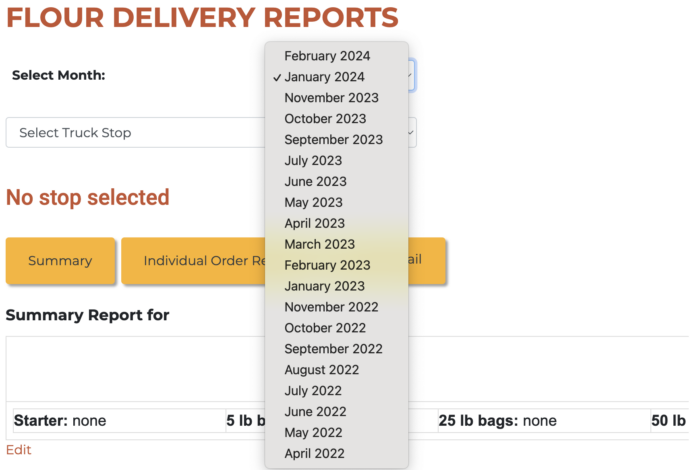
- Then select the truck stop (example is Mukilteo)
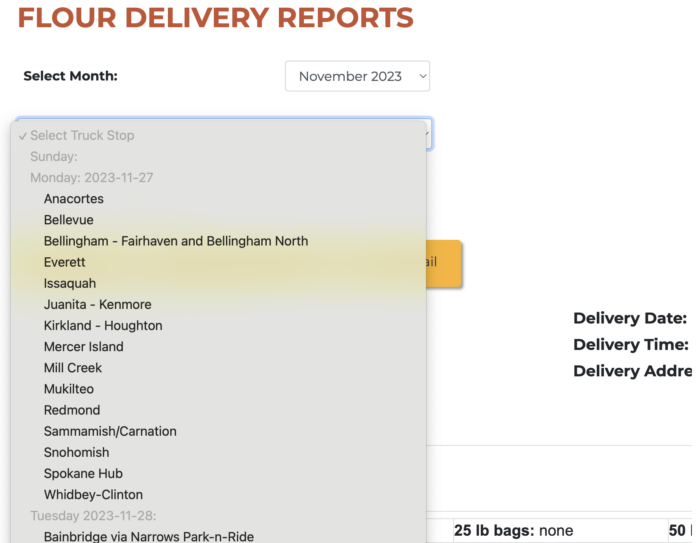
- And then click submit. You can view the “summary” but you can also select “individual orders”. When you do that you’ll see each person who is picking up and what they ordered.
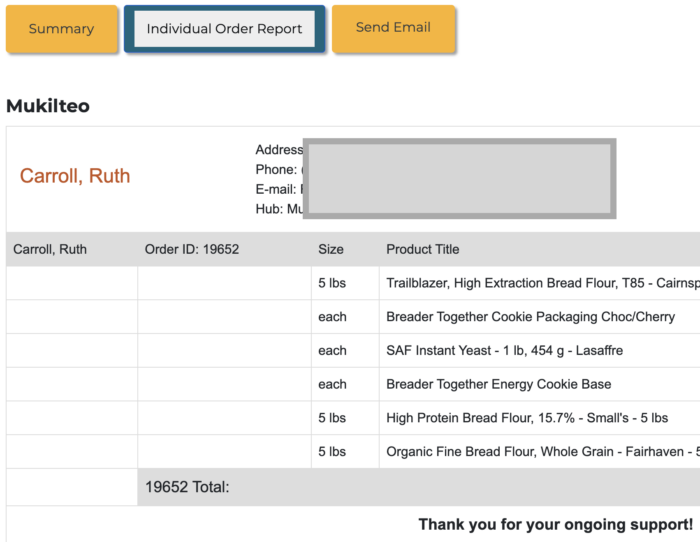
This tool can help you figure out who is missing their order, if you ever end up with extra supplies at the end of pick up day. Each person who ordered and selected “Mukilteo” will be listed as well as their contact information so you can reach out directly to remind them you have their items.
Leave a Reply
What? You’ve not going to be home Sunday for the bread and energy cookie donation? OK, truly, no problem! Of course, it is impossible to be around for every Donation Sunday. Just use your hub tools to keep bakers informed.
For example, you will want to make sure that bakers know you’ll be away, use the Email Tool. You’ll want to make sure you’ve got a volunteer to take the donation to the food bank, use the Volunteer Tasks tool to recruit. And, you’ll want to update the address and any instructions on your Edit Hub tool.
Changing the hub address is a temporary and handy modification. When a baker pre-checks their donation, the email confirmation they receive automatically includes the directions to the temporary location and any special instructions. When you return from the tropics, you can go back to the Edit Hub tool and revise the hub address.
If you have questions on this, please reach out.
Finally, if you are also a truck stop manager and we need to make changes to the delivery drop, please notify Delivery@communityloaves.org. This is really important for smooth operations. That address shows on their supply order confirmations, as well any emailed and/or texted reminder notifications. We want our bakers to go to the correct address to pick up their supplies.
Leave a Reply
Food Bank (1)
Food Banks (1)
Community Loaves is a value add to the exceptional and vital work completed daily at foodbanks throughout the region. As an organization, we love to bake, and we love to donate fresh, nutritious, and delicious items such as our Sandwich Bread and Energy Cookies to our food bank partners.
Becoming a partner is easy and free. It can, however, take a little time to create a brigade of bakers in each geographic location. If you are interested in a Community Loaves effort to support your foodbank, we would love to start the conversation.
To learn more, check out our Foodbank Partner Page.
Leave a Reply
Getting Started (6)
Step-by-Step
- Attended an Information Session.
- Create your volunteer profile and connect with your local baking community.
- Order supplies through our Flour Fundraiser shop.
- Access our signature formulas and bake your bread or energy cookies.
- Package up your baked items and drop them with your hub leader for donation!
Here is a list of the Food Banks We Support.
Volunteer Safety Best Practices & Program Requirements
Guidelines For Safe Food Handling & Packaging
Our donation project is successful thanks to the personal commitment each of our bakers makes to adhering to the following food safety practices:
- Store your ingredients in a clean, dry, and cool environment.
- Store energy cookie base in the refrigerator until you use it, as it contains almond meal.
- Wash your hands and keep your work surface clean.
- Pull long hair back or even better, regardless of hair length, wear a cap, like a ball cap to prevent unwanted hair from falling into your baked goods.
- Make sure loaves and cookies are thoroughly baked, nice brown coloring all the way around. Bread loaves will sound hollow when you gently thump on the bottom.
- Thoroughly cool, to room temperature loaves and/or cookies before packaging. This prevents unwanted condensation from building up inside the packaging.
- Packaging
- When items are completely cooled, use kitchen tongs or a gloved hand to place in the bag. (Avoid placing a warm loaf in the bag, which creates condensation, leading to mold and spoilage.)
- For the bread loaves, squeeze out as much air from the bag as possible, then twist tie tightly closed.
- For the cookies, fold the top of the wax bakery bag over and affix a sticker over the flap to seal. Watch our packaging video in baker resources if you have questions.
- Place items in your freezer or a freezer bank until donation. Or, if donating within 24 hours, place them in a brown paper bag, mark the bag with your name, and take them directly to your designated hub by the drop-off time.
- Home kitchen inspection is not required.
- Baked goods that do not require refrigeration are considered safe to be donated from home kitchens.
Age Requirements
Our requirements regarding volunteering are governed by common sense and insurance standards. The following should provide you the information you need, but please reach out if you have further questions:
- Baker – anyone accepting and following our baking best practices can bake and donate. Younger bakers, middle and high school age can earn volunteer service hours for their time. It is expected that all young bakers will follow the safety practices and follow the recipes precisely.
- Flour Packer – no age limit. However, precision in breaking down 50 lb bags into 5 lb portions is a must. Flour is our thing, so neatness and attention to detail matter.
- Stage and Load the Truck – ability to lift, without struggle, 40 lbs.
- Drive The Truck – Twenty-five years of age or older with a valid driver’s license and insurance.
Leave a Reply
How to Sign Up
All volunteer bakers begin their journey with Community Loaves by attending a virtual information session. This allows you to learn about the organization and the impact of our freshly baked donations. Sign up for one of these sessions here:
Don’t see a time that works? Please contact us and we’ll help you out!
How Long is an Info Session?
Information sessions are just an hour long, with plenty of time for questions. You will leave the session completely prepared to begin baking the world a better place.
I Missed My Session! Now What?
Life happens, we know. You can easily sign up for another session! Just revisit the “Attend Info Session” link above and choose the next available time that matches with your schedule.
Unable to find a session that works with your schedule? There is a possibility we have a recording to share with you. Please email us here.
Leave a Reply
There are two donation opportunities every month, typically the second and fourth Sundays of the month. The schedule can vary in a month due to holidays. Our Community Loaves calendar is set for the entire year to make it easier for our volunteers to plan their baking.
There is no minimum donation requirement. However, our food bank partners can use all the bread and energy cookies we can possibly donate, and demand exceeds supply across the board. Your contributions, when you are able to bake and donate, will be cherished by the food bank clients.
There are some volunteers who have never missed a donation, but more commonly, our volunteer bakers develop a routine that fits into their busy schedules. For some, that is once a month or every other month. Just know that whenever you participate you are helping to nourish your local neighbors in need.
And, our formulas freeze beautifully, which means you can plan ahead! If you know you will be out of town for a donation, you can bake ahead, package, and freeze your donation. On donation Sunday, simply take them out of the freezer and drop at your neighborhood hub. Alternatively, you can make an early donation by taking them to a local freezer bank.
The amount of time donated depends on what you choose to bake. Our bread formula typically takes 6-7 hours, depending on the formula you choose. Of course, being bread, that isn’t all hands-on time. Our Energy Cookie takes about 3 hours, start to finish.
Volunteer Behind the Scenes
Not all our volunteers are bakers! Some dedicate their time to helping this non-profit thrive by packing supplies, assisting with administrative work, and providing volunteer support and service. A host of roles and responsibilities behind the scenes exist that allow us to bake a difference for our food bank partners. If you love what our organization is doing and would like to be involved, but don’t have the time or the interest in turning on your oven, let’s see if we have an opportunity available that might be a better match.Want to learn more? Contact us to ask any questions you might have, or to see what current openings might fit with your interests. You can also sign up to Attend an Info Session.
Leave a Reply
Our Flour Fundraiser
Support Community Loaves every time you purchase flour!
To support our baking efforts, we run a monthly flour fundraiser. This fundraiser gives our volunteer bakers a lovely discount on high-quality professional flours and allows our 501c3 non-profit organization to thrive! Like a sourdough starter, regular “feedings” help to fund our growth and development. Registered volunteers can easily access our online shop for the purchase of essential supplies for the items we bake and donate to our food bank partners.
But, if you aren’t a registered volunteer, and are concerned about having time to bake with us, you can support the mission of Community Loaves and your baking habit at the same time. Every Tuesday from 10:00 – 4:00 pm, our Flour Store is open for drop-in visits. We’re located at 8730 122nd Ave NE, Kirkland. Here, at Flour Central, you can purchase freshly milled flours from the Skagit at a discount to retail, as well as a few specialty flours typically available to professional bakers only. If you have questions on availability, send us an email at bakersupport@communityloaves.org.
In all cases, we strive to keep this program accessible and affordable while ensuring we can support our food banks for years to come.
Make a Doughnation
Each loaf of bread makes a difference and your financial contributions do too!
Food insecurity is on the rise and Community Loaves is committed to being a solution provider, baking delicious and nutritious sandwich bread from our home kitchens and donating these loaves to struggling food pantries across the country.
Your donations advance this nourishing work by helping us expand our network, develop new products, and improve our operations. And all donations are fully deductible. With your help, we can expand to more communities, support more volunteer bakers and feed more people.
We’re exempt from federal income tax under Internal Revenue Code (IRC) Section 501(c)(3). Donors can deduct contributions they make under IRC Section 170. We are qualified to receive tax deductible bequests, devises, transfers or gifts under Section 2055, 2106, or 2522. EIN 32-0619621
Donating from outside the US?
You may run into a challenge making a donation from outside the US. This happened to our Canadian neighbors who were donating in memory of one of our volunteer bakers who lost her battle with cancer.
If you are interested in donating to Community Loaves and run into difficulty during the check-out process, please attempt the following steps:
- Use your normal billing address
- Check the “Use a different shipping address box” located to the right of the screen.
- Enter our Community Loaves address as the shipping address. Community Loaves, 8730 122nd Ave NE, Kirkland, WA 98033
If you are still encountering issues, please contact us directly at info@communityloaves.org.
Thank you in advance for considering making a contribution to Community Loaves!
Leave a Reply
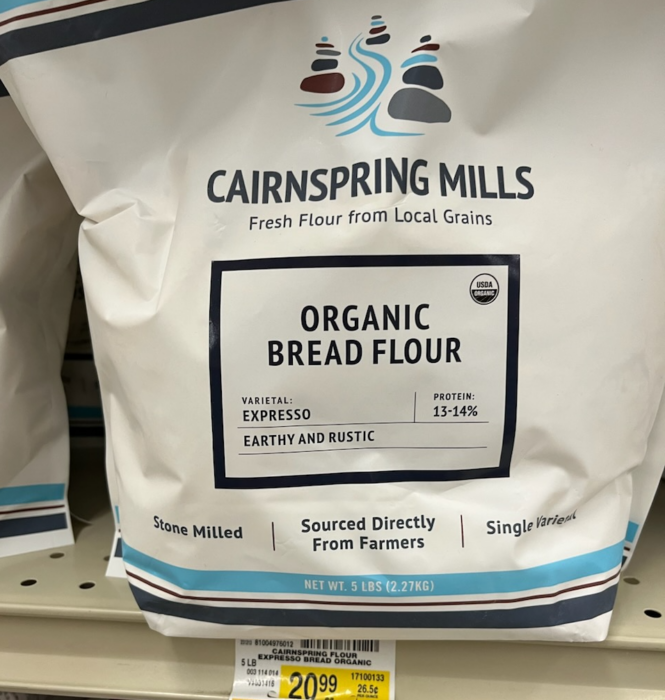
Community Loaves is a 501c(3) non-profit organization, and as such we depend on our Flour Fundraiser and generous donations to cover our program expenses. The sales from our monthly Flour Fundraiser provide much needed assistance and support to our expanding volunteer network.
Through our Flour Fundraiser, we are able to offer ingredients and supplies at a significant discount compared to retail prices. For example, a 5lb bag of Cairspring Mills Trailblazer flour costs $20.99 at the grocery store, our bakers can purchase the same 5lb bag for only $10.95! A special discount for you, that simultaneously supports local flour mills, and raises a few dollars for our non-profit. That’s what we call a Win.
Ingredient & Packaging Costs For A Loaf Of Bread:
The current cost to make and bake one loaf of bread is $2.84, including the packaging. This can vary, especially in our expanded markets like California or Idaho. If you purchase different flour or types of ingredients, for example, specialty honey or farmer’s market oats, the loaf price could be higher. Our price used Costco honey, oatmeal, and olive oil. For the flour, we used our Community Loaves flour store pricing. Bakers are given a 6-hour donation of time credit for every batch of 3-4 loaves donated. Use this time credit to satisfy community service requirements or request corporate matching! Our non-profit benefits greatly from corporate matching!
Ingredient & Packaging Costs Per Energy Cookie:
The donated cost per Breader Together Energy Cookie is $0.88 cents per cookie, fully packaged. We used average store pricing for the ingredients beyond our signature cookie base – items like unsweetened apple sauce, pecans, cornmeal, blueberries, and raw sugar…. An entire batch of cookies (32) costs $28.23 and takes approximately 3 hours to mix, bake and package.
Our volunteer bakers give their time, talent, and treasure to bake and donate our signature honey oat sandwich bread and energy cookies to our local food bank partners. It is a big, beautiful volunteer project and we track all gifts.
Volunteer time for younger bakers can be used to satisfy community service requirements or, for those in industry, serve as support in the request for corporate matching.
Every donation is logged on your volunteer baker profile, and you can pull a giving statement anytime. The giving statement records the total items donated, the volunteer time to complete those donations, and the financial cost.
Volunteers can download their current doughnation statement anytime! It is found on your volunteer profile page.
Leave a Reply
Community Loaves is a value add to the exceptional and vital work completed daily at foodbanks throughout the region. As an organization, we love to bake, and we love to donate fresh, nutritious, and delicious items such as our Sandwich Bread and Energy Cookies to our food bank partners.
Become a Partner
Becoming a partner is easy and free. It can, however, take a little time to create a brigade of bakers in each geographic location. If you are interested in a Community Loaves effort to support your foodbank, we would love to start the conversation.
To learn more, check out our Foodbank Partner Page.
Leave a Reply
Getting Started (6)
So many bakers watching the bread tutorial videos have asked, where can I find those large bowl covers.
Aren’t they great?!
I purchased these through Amazon. They are part of a set, containing multiple sizes. The largest size is great. I’ve put these covers to use for 3 years how and they are still going strong. Simply wash after use and then put back in the drawer.
Here is a link to them on Amazon: REUSABLE ELASTIC FOOD STORAGE BOWL COVERS
Let us know if you have any questions or an even better source!
Bake a quantity of loaves that fits your equipment or physical capacity. The standard recommendation is four loaves: three to donate and one for you and your family to enjoy.
But that might not work for your size mixer, kitchen, or maybe you can make more. Make the batch size that works for you and please keep a loaf to nourish you and your family.
Leave a Reply
Shoot, your schedule suddenly opened up and you could have baked bread! You still can!
All our loaves begin with a pre-ferment. Typically, an 8-10 hour pre-game element brings delicious flavor to our loaves. But, if you didn’t plan to bake bread, is there a way to complete a one-day process? Yes, our modern formula uses a poolish, vs. a levain (sourdough). A poolish is simply a preferment made with flour, water, and conventional yeast. And, if you are in a pinch for time, as in you want to do a same-day bake, you can simply double the yeast in the pre-ferment.
Come Again: Simply follow the instructions on the formula/recipe for the poolish but double the yeast. That’s it. The same day, pre-ferment will be ready to go in 4 hours.
Fresh whole grain bread, start to finish, in a day!
Leave a Reply
The great thing about Community Loaves is that you can literally bake whenever it works for your personal schedule, as long as you have access to a freezer.
However, if you don’t have access to a freezer or freezer bank, then you are a Saturday baker. You’ll want to bake on Saturday, package the items on Sunday (which provides plenty of time for loaves and cookies to cool), and then transport them to your designated hub.
Otherwise, you can bake any day of the week that suits your schedule. You’ll still package these beauties up the next day after they’ve had plenty of time to cool (see our Packaging and Freezing guidelines). Then pop the packaged items into your freezer or get them to a freezer bank. What’s a freezer bank? Learn more here.
Leave a Reply
How To Donate (14)
Our requirements regarding volunteering are governed by common sense and insurance standards. The following should provide you the information you need, but please reach out if you have further questions:
- Baker – anyone accepting and following our baking best practices can bake and donate. Younger bakers, middle and high school age can earn volunteer service hours for their time. It is expected that all young bakers will follow the safety practices and follow the recipes precisely.
- Flour Packer – no age limit. However, precision in breaking down 50 lb bags into 5 lb portions is a must. Flour is our thing, so neatness and attention to detail matter.
- Stage and Load the Truck – ability to lift, without struggle, 40 lbs.
- Drive The Truck – Twenty-five years of age or older with a valid driver’s license and insurance.
Leave a Reply
1. Let your hub leader know you’re coming by pre-checking your donation. You’ll find the red donation button on your volunteer dashboard in the Make A Donation section. Select the first box on the left, Loaves & Cookies. It looks like this:

2. You can check your loaves or cookies at any hub or freezer bank that is convenient for you. (Typically, the most convenient is your neighborhood hub.)
3. Heading out of town for the weekend? You can also check your items into one of our freezer banks. Select that radial button, and then from the list, the freezer that is closest to you. Using our freezer banks gives you the ultimate flexibility in your donation timing.
4. You will receive an email confirmation that your items have been pre-checked.
Leave a Reply
We donate twice a month. The calendar is set a year in advance. Our intent when setting the calendar is to minimize overlapping with holidays, where our food bank partners might be closed, or our volunteer bakers otherwise occupied.
Additionally, when setting dates we intentionally avoid back-to-back donations. Finally, we do not bake and donate in August. For the health of the organization, hub leaders, operations people, bakers, we all need a break, and frankly it is also too hot to bake! That said, for those diehard bakers, those who must bake, it is a great time to freeze your donation and stock up for September.
Speaking of freezers. Using our “freezer banks” is the perfect way to volunteer on your own time. Heading out of town for the weekend? Pre-check your loaves in one of our “freezer banks”. Your donation karma is secured and you don’t have to worry about getting home on time. Learn More Here.
Our program calendar is a terrific resource for all dates, you find that on your volunteer dashboard, right at the top. And, for convenience, we’ve included the full 2024 list below as well.
| Donation 1 | Donation 2 | |
| January | 1/14/2024 | 1/28/2024 |
| February | 2/11/2024 | 2/25/2024 |
| March | 3/10/2024 | 3/24/2024 |
| April | 4/7/2024 | 4/21/2024 |
| May | 5/5/2024 | 5/19/2024 |
| June | 6/9/2024 | 6/23/2024 |
| July | 7/14/2024 | 7/28/2024 |
| August | No Donations | |
| September | 9/8/2024 | 9/22/2024 |
| October | 10/13/2024 | 10/27/2024 |
| November | 11/10/2024 | 11/24/2024 |
| December | 12/8/2024 | 12/22/2024 |
Leave a Reply
A special donation is a way for us to provide a little extra heart and care to our food bank partners and their clients, specifically around holidays. Baking and donating the special items is fun and adds a little variety and spice to our usual donations. Not your thing, special donations are optional.
We have two scheduled special donations in 2024:
- The second donation in November, in preparation for the Thanksgiving Meal boxes our food banks often provide their clients, volunteers are encouraged to convert their bread loaves into rolls. You can use the same packaging. See this video for instructions and recommendations on how to make rolls.
- The second donation in December, ‘Tis the Season to extend cheer and best wishes for the New Year! We do this with a signature holiday cookie box. The cookie that is baked is the winner of our annual holiday cookie competition. Click here to see a list of the 2023 winner and all the entries.
Leave a Reply
One of our favorite questions! Yes, we do provide these hours. You will find them on your volunteer profile page. You receive hours for baking and donating loaves and cookies, packing flour, packing cookie mix, serving as a hub leader, driving and/or organizing supplies, and helping out your hub leader. Just about every aspect of the program acknowledges your dedication with a volunteer time credit!
To find, view, and print your “statement”:
- Login to your volunteer dashboard.
- Click the yellow “Profile” button.
- Scroll down, you’ll see some options for viewing your statement. This year, last year and then click to view as a pdf. You can also see all of this year’s donations itemized right ther on the profile page.
- Donations are calculated as follows – 6 hours for every combination of 3-4 loaves of bread donated and 3 hours for every batch of cookies. These are based on existing averages.
- Note our EIN number is on the statement to make it easy for you when you file your annual tax return.
We track these efforts intentionally, young bakers can earn Community Service credit, and working bakers can submit their time with their companies for corporate matching. Those are really valuable dollars for this little non-profit organization.
If you need additional information to complete your submission, please send an email to bakersupport@communityloves.org
Leave a Reply
We are thrilled to participate as a charitable organization in Washington Combined Fund Drive. Here our volunteers can extend their generosity through direct giving.
If you are employed by WA state, including any of our state colleges and institutions and/or at the Port of Olympia, Seattle Housing Authority, and Snohomish County PUD you can participate!
Our OSOS Charity Program # is 1483063
It couldn’t be easier to set up. Click on the banner linked below.
Leave a Reply
Heading out of town, want to drop your loaves off early? You don’t have to miss a donation, you can bake ahead and take your items to your nearest freezer bank.
A freezer bank is an independent donation location; it is like a hub, and sometimes it is located at your hub. The difference is unlike your hub check-in, where the donations are organized for Sunday. Freezer banks can take donations at any time, well, within reason, that is. Then the freezer bank manager makes sure that your loaves and/or cookies are transferred to the food bank for the next donation date.
You’ll find the Freezer Bank opportunity in the same location as your regular Donation Check-In.
1. Click the Loaves/Cookies Button

2. Select “Freezer Bank”

3. Click the down arrow to reveal the location opportunities. We are adding more and more freezer banks as the weeks and months progress

After checking in your items, your confirmation message will provide the details for reaching out to the freezer bank manager. You can confirm via text, email or phone that you’ll be bringing by your items for cold storage. Then head off to the Bahamas with peace of mind and the positive vibes of a donation that is in the bank!
One of the best things about Community Loaves is that moving to a new neighborhood doesn’t mean you have to give up baking and donating.
When you started the program, you created a volunteer profile and selected your hub. Now that you’ve moved, you’ll probably want to change your hub to one that is closer to your new residence. Here’s what you need to do….
1. Click on the yellow profile button on your volunteer Dashboard.

2. Scroll down about 1/3 – you’ll see “Change Hub”. Click to edit.

3. Scroll down, type in your zip code and select the hub closest to your new home. Don’t forget to hit “Submit” at the bottom.

4. That’s it. Now you’re part of a new hub and they’ll be expecting you next donation Sunday!
Leave a Reply
You may run into a challenge making a donation from outside the US. This happened to our Canadian neighbors who were donating in memory of one of our volunteer bakers who lost her battle with cancer.
If you are interested in donating to Community Loaves and run into difficulty during the check-out process, please attempt the following steps:
- Use your normal billing address
- Check the “Use a different shipping address box” located to the right of the screen.
- Enter our Community Loaves address as the shipping address. Community Loaves, 8730 122nd Ave NE, Kirkland, WA 98033
The image below shows a completed form.

If you are still encountering issues, please contact us directly at info@communityloaves.org.
Thank you in advance for considering making a contribution to Community Loaves!
Have an extra freezer? Want to become a drop point for donations? Freezer banks allow bakers to drop off their donations at times outside of the usual Sunday donation day: easier for those with unconventional schedules, or when vacations or other responsibilities interfere with a Sunday drop off.
As the freezer bank manager, you will be responsible for making sure that the loaves and cookies donated to your freezer are transferred to the food bank for the next donation date. This might mean bringing them to your hub along with your own donations on donation Sunday, or it might be that you drop them off yourself at the food bank Monday.
Still interested? Send us a message and we’ll get back to you soon!
On your Dashboard, you’ll find a Calendar icon (see below). We list all of our program events on this calendar, from delivery days, to donation days, to food bank tours, and so on.

If you hover over an event on the calendar, you will see a pop-up box with more event info. Clicking on an event will take you to its full information page, with its location, time, and volunteer sign-up link (if applicable) listed.

Leave a Reply
The great thing about Community Loaves is that you can literally bake whenever it works for your personal schedule, as long as you have access to a freezer.
However, if you don’t have access to a freezer or freezer bank, then you are a Saturday baker. You’ll want to bake on Saturday, package the items on Sunday (which provides plenty of time for loaves and cookies to cool), and then transport them to your designated hub.
Otherwise, you can bake any day of the week that suits your schedule. You’ll still package these beauties up the next day after they’ve had plenty of time to cool (see our Packaging and Freezing guidelines). Then pop the packaged items into your freezer or get them to a freezer bank. What’s a freezer bank? Learn more here.
Leave a Reply
Yes, absolutely, you can still donate those items.
Now, having said that. If you can tie a string around your finger and remember to pre-check for the future, that would be very helpful. Pre-checking your donation is a real courtesy to your hub manager. It makes easy work for them to submit the final counts on donation Sunday. Here is a reminder of our pre-check process.
When you pre-check your donation, it is automatically listed on a printed sheet, placed on a clipboard, and you can simply scribble your initials and dash. No paper bag with your name is needed. Further, it is much easier for a hub leader to estimate the number of bins/boxes to put out. Rest assured, even if your count changes between the pre-check and the physical donation, as when a spouse unexpectedly cuts into one of the loaves, you can easily make a note on the printed check-in sheet.
Baking and donating is wonderful. Baking, pre-checking, and donating is divine!
We have great systems but sometimes we humans miss something!
If you don’t see your recent donation on your volunteer profile, it could have been missed in the final number count submitted by your hub leader. To prevent this from happening it is a good idea to pre-check your donations prior to a Sunday donation. But, even then, this can happen and it is easily remedied.
Send a quick email to your hub leader apprising them of the missing numbers and they can submit an edit to the count. Once that edit has been entered by the hub leader it takes 24 hours for update to take place.
Hub Coordinator (11)
Sometimes it is hard to know what to say in the twice-a-month cheerleading for your hubs. Here are a couple of emails that could serve as inspiration.
From Sandy Merrit-Shea to her hub leaders, following a recent donation:
Good Morning Bonney Lake Hub Bakers!
This Sunday, the 25th, is donation day. So get those bread loaves and Energy Cookies ready to be dropped off! Here is the info: 18402 139th St E. from 9 am – 5 pm. Donation bin on the front porch w/signup sheet on a clipboard.
Remember to record #’s today on the website, too. The Bonney Lake Food Bank will be closed on Monday the 26th, so I will deliver to them on Tuesday. If you would like to drop off donations to the hub on Monday, to keep everything frozen one more day, I will be here. Whichever day works best for you, Sunday or Monday, just text me if you would like to drop off on Monday.
Let’s welcome our newest bakers to join our baking brigade, Julia Osborne and Amy Vandenberg! We are all so happy to have you with us on this journey to provide for our community; the Bonney Lake Food Bank thank you!
We also have some One Year Anniversaries to celebrate. Let’s give a round of applause to Gretchen McCallum, Wendy Adams, Amanda Kruger and Glenda Brown! Thank you, Ladies, for helping to build our little hub into what it has become, I’m in awe of you all…Thank you!
It would be great to have everyone upload a picture on your profile page on the Community Loaves website. Always so nice to have a face to go with your name, and I’ve even seen some of you out in the community, I love that!
We truly are Breader Together!
Sandy Merritt-Shea, Bonney Lake Hub Coordinator
We have a new tool that allows you to send a quick note or an animated card to a baker, or your whole hub. SO fun! However, this is different from our email tool, and it looks like this:

Here’s how it can be accessed:
-
- Click “Messages” in the blue bar at the top of your Dashboard. This will take you to the page view seen above. If you have a new message, a notification will show up next to “Messages” (just like you can see “4 New!” next to Volunteer Tasks, below).

2. Click on “View Latest Donation Highlights”

This will take you to the Donation Highlights page, where you can view organization totals, baker anniversaries and badges earned, and hub specific numbers for any donation date you choose from the drop down menu. You can toggle between Organization Totals and View My Hub Only to change what you’re seeing on the page.
Tabs allow you to view the names of bakers who are celebrating anniversaries, or have earned specific badges during the donation date chosen. Click on the green “Say Congratulations” button next to a baker’s name.

3. Access a list of all your hub members from the Your Hub button located on your main Dashboard.

Then scroll down to the grid of friendly faces, and click on the little red envelope icon. This will take you to the messaging tool and you can choose a card to send, or just send a quick note.

Leave a Reply
Hub Leaders can select one or more hub members to become Hub Delegates. This delegate role gives another person (or people) all the hub leader tools, so that you have a back up in case of travel, emergency, illness, etc.
Click the Delegate Duties button, and then use the drop down menu beside the name of the baker(s) to give them the “Delegate” role. (see below)

If you have very small hub and need a larger group of volunteers to pull from, you are able to select a member from an affiliate hub to become a delegate of your hub. Use the drop down menu under “Select a Member of an Affiliated Hub” and select a name. They will then be added to your list of Hub members, and you can change their role. (see below)

Do you currently have a hub delegate? How do you like to utilize their help? Have anything to share with us about delegating duties? Please do so in the comments below.
Leave a Reply
Delegates can do more than just help you out in a pinch or when you’re on vacation. Once you’ve assigned someone the role of “Delegate,” they’ll have access to all of the same tools that you do as a hub leader.
Examples of tasks you might hand off to a delegate:
Maybe you don’t mind being a drop off spot for Donation Sunday, but don’t have the bandwidth for a delivery trip to the food bank on Monday. Perhaps there’s a hub member to whom you could delegate this task, and who would love to be that link in the donation cycle.
You can also have a delegate help you be a cheerleader for you hub and send out communications a few times a month to your bakers:
- Congratulation cards in our messaging system for baker anniversaries and new badges earned
- Donation follow up emails to thank your bakers for their efforts
Don’t be shy! This organization is full of incredible volunteers who love to lend a hand to help make this machine run smoothly. If you need help, or would like to share the load, ask a delegate!
You may also refer to our “Volunteer Tasks” FAQ to learn more about getting help with one-off tasks.
Leave a Reply
All volunteer bakers need supplies which can be ordered directly through the Flour Fundraiser Store.
As a hub leader you can view the orders your hub members order, even if the supplies are delivered to a different location. You can pull a list of everyone who has ordered to pick up at your hub.
Here are the steps in a couple screen captures:
- Select the Flour Delivery green tab from your hub tools. (see image above)
- Then select the delivery month

- Then select the truck stop (example is Mukilteo)

- And then click submit. You can view the “summary” but you can also select “individual orders”. When you do that you’ll see each person who is picking up and what they ordered.

This tool can help you figure out who is missing their order, if you ever end up with extra supplies at the end of pick up day. Each person who ordered and selected “Mukilteo” will be listed as well as their contact information so you can reach out directly to remind them you have their items.
Leave a Reply
Great Hub Leaders Ask For Help!
Our Volunteer Task Tool exists to help you – plan ahead, easily request help from your Hub and automatically awards valuable donation time as a thank you for their efforts.
The Volunteer Tasks button allows you to create volunteer tasks whenever you need help. Watch the video below, or scroll down to see the step-by-step.
Step-by-step:
1. Once you have clicked on the Volunteer Tasks button, you can scroll down and click on “Create Task.”

2. In the “Task Title” field, select from predefined tasks or create your own by selecting Custom.

3. Volunteer tasks automatically record to the Volunteer Dashboard of your own hub. If you have affiliate hubs, you may select for them to also receive the sign up notificiation by checking the box next to their name at the bottom of the page. (see above)
** Tip: Once you’ve created a task, copy the link to it and share it with your entire hub, using our email tool, to encourage signup! **
Once the task is completed you will be prompted to acknowledge the time donation, which you can do at the top of the Volunteer Tasks page. Once time donations have been submitted, a thank you is automatically sent and the time is recorded on their profile.
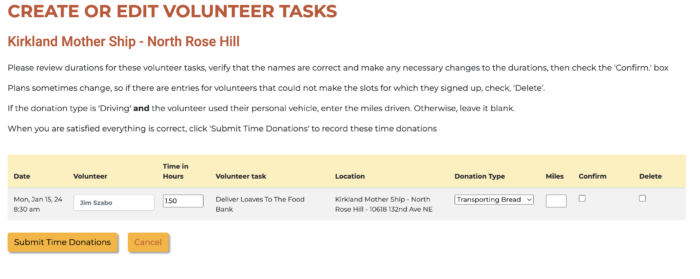
You can also create a “Delegate” – great for hub management – they get all the tools! Learn more about delegates here.
Leave a Reply
As a hub leader, one of the most important jobs you have is being a cheerleader for your bakers. Engaging with bakers and letting them know how appreciated and impactful their donations are is truly the best way to keep them baking.
A post Donation Day recap email is a great way to regularly engage with your hub. Every post-Donation day Monday morning, we send out an email recap with your hub’s donation details and highlights – how many loaves and cookies were donated, who has earned new badges, and who has met new milestones. You can also find those stats through the donation record (located in Donation Reports, in the Special Admin Section of your Dashboard). We recommend sending these emails out to all bakers in your hub, active and inactive, as these can be highly motivating emails and might lure back bakers who have fallen out of the habit of baking regularly.
* As a reminder, all emails and communications should be sent through the Community Loaves Email tool or messaging system. *
Leave a Reply
What? You’ve not going to be home Sunday for the bread and energy cookie donation? OK, truly, no problem! Of course, it is impossible to be around for every Donation Sunday. Just use your hub tools to keep bakers informed.
For example, you will want to make sure that bakers know you’ll be away, use the Email Tool. You’ll want to make sure you’ve got a volunteer to take the donation to the food bank, use the Volunteer Tasks tool to recruit. And, you’ll want to update the address and any instructions on your Edit Hub tool.
Changing the hub address is a temporary and handy modification. When a baker pre-checks their donation, the email confirmation they receive automatically includes the directions to the temporary location and any special instructions. When you return from the tropics, you can go back to the Edit Hub tool and revise the hub address.
If you have questions on this, please reach out.
Finally, if you are also a truck stop manager and we need to make changes to the delivery drop, please notify Delivery@communityloaves.org. This is really important for smooth operations. That address shows on their supply order confirmations, as well any emailed and/or texted reminder notifications. We want our bakers to go to the correct address to pick up their supplies.
Leave a Reply
The hub leadership was never intended to be a lifetime role. We recognize the time will come when you will be ready or will need to pass the proverbial baguette. The following process will help to guide this effort and create a smooth transition and continuity for our Breader Together efforts.
FYI – It is helpful to transition hubs at specific times of the calendar year when other activities for our non-profit are slower. If you can plan for an August or December transition, that is ideal. Life events don’t always happen at an ideal time, but if we have the luxury of time, August or December are best.
Here are the steps:
- Notify Katherine that you’re looking to find new leadership for the hub.
- Together, you’ll talk through any logical successor candidates, perhaps existing delegates and/or super helpful hub members.
- You’ll agree on a desired timeline and a communication plan to the hub to solicit interest.
- Any interested candidates will need to attend a hub training session. You and Katherine will encourage folks to attend this hub leader training.
- Although only one person can be a hub leader, the opportunity to train multiple people at once helps create a knowledgeable leadership team that can support one another.
- In the unlikely event that nobody emerges able/willing to take on these responsibilities, the hub will be closed, and hub members will be reassigned to the next closest hub.
Please notify Katherine (katherine@communityloaves.org) if you would like to begin the hub transition process.
Leave a Reply
Hub Leader Role (2)
We don’t use the word “essential” lightly. Our ability to deliver loaves and energy cookies twice a month is dependent on a cheerleader coordinator within the community. This hub leader serves as an anchor for the volunteer bakers in a specific geographic area and in support of a specific food bank partner or partners.
A robust set of tools has been built to make the cheerleading easy to execute or to delegate to helpful volunteers.
On average the volunteer time needed to be a hub leader is 10 hours or so a month. Most of that is passive time, receiving the donations twice a month. But active time is what helps us build community and improve our impact to our food bank partners.
Here is a short list of the essential tasks to be a hub leader:
- Communication – twice a month email communication using the CL email tool. Provide meaningful updates and/or requests to your hub members. Topics include…
- New Program Logistics – (Holiday Cookie, New Formulas, Supply Delivery…)
- Major member milestones – (anniversaries, volunteer time, achievements)
- Request help from hub members – ask for assistance getting the donation to the food bank
- Reinforce the value of the donation to the food bank – updates from the partnered food bank.
- Manage Bread & Cookie Donation – ensure that the loaves and cookies get to the food bank. (This doesn’t mean taking them yourself, it is an easy task to request help from others.)
- Understand the monthly local delivery or shipment process for supplies. If you manage a local shipment that involves a couple of hours each month.
- Coordinate an annual food bank tour – individually or in concert with other hubs that support the same food bank. This is also a great “task” for an enthusiastic hub member.
What follows are the essential agreements to be a CL hub leader:
- Your Photo or Avatar will be part of your profile – this livens up the CL Community and creates a familiar face for hub members to find.
- The existing partnered food bank will be the exclusive beneficiary – you cannot solicit new partners independently, but working with Community Loaves HQ, new partnerships may be pursued as needed.
- Use the hub leader management tools exclusively for all CL functions.
- Ask bakers to use the support resources directly vs. serving as a liaison for logistics inquiries. Creates unnecessary complexity – FAQ’s. (orders@communityloaves.org, info@communityloaves.org )
- Stay in contact and elevate any concerns or recommendations directly to me – your ideas big or small, help us continue to build a stronger program – katherine@communityloaves.org
- Any and all press inquiries need to be directed to Community Loaves. From there we will respond as a team.
- All branding and communication elements are the property of Community Loaves and usage needs to be approved by the mothership.
- Creation of any tools – including handouts, flyers, cards, etc.. to support the Community Loaves effort need to be approved by Katherine Kehrli and the communications team.
The hub leadership was never intended to be a lifetime role. We recognize the time will come when you will be ready or will need to pass the proverbial baguette. The following process will help to guide this effort and create a smooth transition and continuity for our Breader Together efforts.
FYI – It is helpful to transition hubs at specific times of the calendar year when other activities for our non-profit are slower. If you can plan for an August or December transition, that is ideal. Life events don’t always happen at an ideal time, but if we have the luxury of time, August or December are best.
Here are the steps:
- Notify Katherine that you’re looking to find new leadership for the hub.
- Together, you’ll talk through any logical successor candidates, perhaps existing delegates and/or super helpful hub members.
- You’ll agree on a desired timeline and a communication plan to the hub to solicit interest.
- Any interested candidates will need to attend a hub training session. You and Katherine will encourage folks to attend this hub leader training.
- Although only one person can be a hub leader, the opportunity to train multiple people at once helps create a knowledgeable leadership team that can support one another.
- In the unlikely event that nobody emerges able/willing to take on these responsibilities, the hub will be closed, and hub members will be reassigned to the next closest hub.
Please notify Katherine (katherine@communityloaves.org) if you would like to begin the hub transition process.
Leave a Reply
Hub Leader Tools (7)
Hub Leaders can select one or more hub members to become Hub Delegates. This delegate role gives another person (or people) all the hub leader tools, so that you have a back up in case of travel, emergency, illness, etc.
Click the Delegate Duties button, and then use the drop down menu beside the name of the baker(s) to give them the “Delegate” role. (see below)

If you have very small hub and need a larger group of volunteers to pull from, you are able to select a member from an affiliate hub to become a delegate of your hub. Use the drop down menu under “Select a Member of an Affiliated Hub” and select a name. They will then be added to your list of Hub members, and you can change their role. (see below)

Do you currently have a hub delegate? How do you like to utilize their help? Have anything to share with us about delegating duties? Please do so in the comments below.
Leave a Reply
Delegates can do more than just help you out in a pinch or when you’re on vacation. Once you’ve assigned someone the role of “Delegate,” they’ll have access to all of the same tools that you do as a hub leader.
Examples of tasks you might hand off to a delegate:
Maybe you don’t mind being a drop off spot for Donation Sunday, but don’t have the bandwidth for a delivery trip to the food bank on Monday. Perhaps there’s a hub member to whom you could delegate this task, and who would love to be that link in the donation cycle.
You can also have a delegate help you be a cheerleader for you hub and send out communications a few times a month to your bakers:
- Congratulation cards in our messaging system for baker anniversaries and new badges earned
- Donation follow up emails to thank your bakers for their efforts
Don’t be shy! This organization is full of incredible volunteers who love to lend a hand to help make this machine run smoothly. If you need help, or would like to share the load, ask a delegate!
You may also refer to our “Volunteer Tasks” FAQ to learn more about getting help with one-off tasks.
Leave a Reply
All volunteer bakers need supplies which can be ordered directly through the Flour Fundraiser Store.
As a hub leader you can view the orders your hub members order, even if the supplies are delivered to a different location. You can pull a list of everyone who has ordered to pick up at your hub.
Here are the steps in a couple screen captures:
- Select the Flour Delivery green tab from your hub tools. (see image above)
- Then select the delivery month

- Then select the truck stop (example is Mukilteo)

- And then click submit. You can view the “summary” but you can also select “individual orders”. When you do that you’ll see each person who is picking up and what they ordered.

This tool can help you figure out who is missing their order, if you ever end up with extra supplies at the end of pick up day. Each person who ordered and selected “Mukilteo” will be listed as well as their contact information so you can reach out directly to remind them you have their items.
Leave a Reply
Great Hub Leaders Ask For Help!
Our Volunteer Task Tool exists to help you – plan ahead, easily request help from your Hub and automatically awards valuable donation time as a thank you for their efforts.
The Volunteer Tasks button allows you to create volunteer tasks whenever you need help. Watch the video below, or scroll down to see the step-by-step.
Step-by-step:
1. Once you have clicked on the Volunteer Tasks button, you can scroll down and click on “Create Task.”

2. In the “Task Title” field, select from predefined tasks or create your own by selecting Custom.

3. Volunteer tasks automatically record to the Volunteer Dashboard of your own hub. If you have affiliate hubs, you may select for them to also receive the sign up notificiation by checking the box next to their name at the bottom of the page. (see above)
** Tip: Once you’ve created a task, copy the link to it and share it with your entire hub, using our email tool, to encourage signup! **
Once the task is completed you will be prompted to acknowledge the time donation, which you can do at the top of the Volunteer Tasks page. Once time donations have been submitted, a thank you is automatically sent and the time is recorded on their profile.

You can also create a “Delegate” – great for hub management – they get all the tools! Learn more about delegates here.
Leave a Reply
As a hub leader, one of the most important jobs you have is being a cheerleader for your bakers. Engaging with bakers and letting them know how appreciated and impactful their donations are is truly the best way to keep them baking.
A post Donation Day recap email is a great way to regularly engage with your hub. Every post-Donation day Monday morning, we send out an email recap with your hub’s donation details and highlights – how many loaves and cookies were donated, who has earned new badges, and who has met new milestones. You can also find those stats through the donation record (located in Donation Reports, in the Special Admin Section of your Dashboard). We recommend sending these emails out to all bakers in your hub, active and inactive, as these can be highly motivating emails and might lure back bakers who have fallen out of the habit of baking regularly.
* As a reminder, all emails and communications should be sent through the Community Loaves Email tool or messaging system. *
Leave a Reply
Making Your Donation (9)
1. Let your hub leader know you’re coming by pre-checking your donation. You’ll find the red donation button on your volunteer dashboard in the Make A Donation section. Select the first box on the left, Loaves & Cookies. It looks like this:

2. You can check your loaves or cookies at any hub or freezer bank that is convenient for you. (Typically, the most convenient is your neighborhood hub.)
3. Heading out of town for the weekend? You can also check your items into one of our freezer banks. Select that radial button, and then from the list, the freezer that is closest to you. Using our freezer banks gives you the ultimate flexibility in your donation timing.
4. You will receive an email confirmation that your items have been pre-checked.
Leave a Reply
Heading out of town, want to drop your loaves off early? You don’t have to miss a donation, you can bake ahead and take your items to your nearest freezer bank.
A freezer bank is an independent donation location; it is like a hub, and sometimes it is located at your hub. The difference is unlike your hub check-in, where the donations are organized for Sunday. Freezer banks can take donations at any time, well, within reason, that is. Then the freezer bank manager makes sure that your loaves and/or cookies are transferred to the food bank for the next donation date.
You’ll find the Freezer Bank opportunity in the same location as your regular Donation Check-In.
1. Click the Loaves/Cookies Button

2. Select “Freezer Bank”

3. Click the down arrow to reveal the location opportunities. We are adding more and more freezer banks as the weeks and months progress

After checking in your items, your confirmation message will provide the details for reaching out to the freezer bank manager. You can confirm via text, email or phone that you’ll be bringing by your items for cold storage. Then head off to the Bahamas with peace of mind and the positive vibes of a donation that is in the bank!
Have an extra freezer? Want to become a drop point for donations? Freezer banks allow bakers to drop off their donations at times outside of the usual Sunday donation day: easier for those with unconventional schedules, or when vacations or other responsibilities interfere with a Sunday drop off.
As the freezer bank manager, you will be responsible for making sure that the loaves and cookies donated to your freezer are transferred to the food bank for the next donation date. This might mean bringing them to your hub along with your own donations on donation Sunday, or it might be that you drop them off yourself at the food bank Monday.
Still interested? Send us a message and we’ll get back to you soon!
My loaves didn’t turn out as planned, can they still be donated? We’ve received scores of inquiries with pictures asking this very question. Not all loaves are Instagrammable, but often, they can still be donated!
Divots and dimples are a sign that your loaves are slightly or greatly over-proofed. Generally, they aren’t as attractive as that beautiful domed loaf, but they sure are tasty and definitely worthy of donation. What about underproofed loaves? The telltale signs of a split at the sides or top again make the loaf a little less attractive but certainly donatable.
OK – what about loaves that are too dark, too short, or just really don’t look like a loaf? Well, now we have a challenge. A good rule of thumb: would you enjoy the loaf as a family? If yes, donate it. If the answer is no, perhaps your kiddo might utter an “EWWW”, maybe that loaf is destined for the compost bin. Gratefully, flour is relatively inexpensive and you can try again. A loaf that is short and squat, looks like a brick, well that is probably not the loaf anyone will take at the food bank so keep it for yourself, make bread crumbs and start again.
Speaking of Starting Again: Consider attending a Baker Debrief session. The collective experience of the attendees will help you work the chinks out of your loaves. We can help you get from wonky to perfect in no time! All Baker Debrief sessions are listed on our volunteer calendar HERE.
Still unsure: Send us a snap of your funky loaf! We’re happy to give our two cents. Email us at bakersupport@communityloaves.org.
Sample images below, for reference purposes, may provide additional assistance.

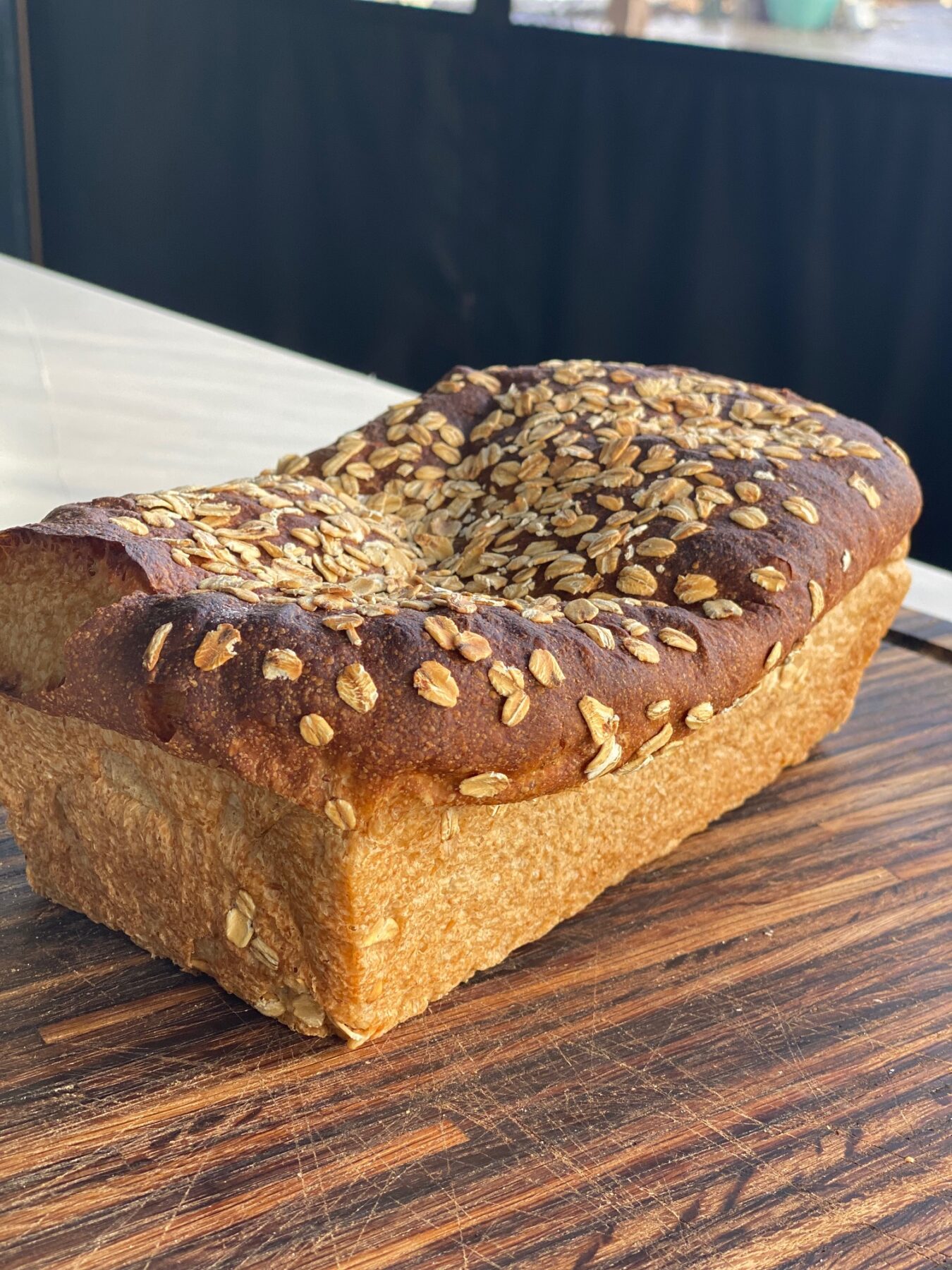
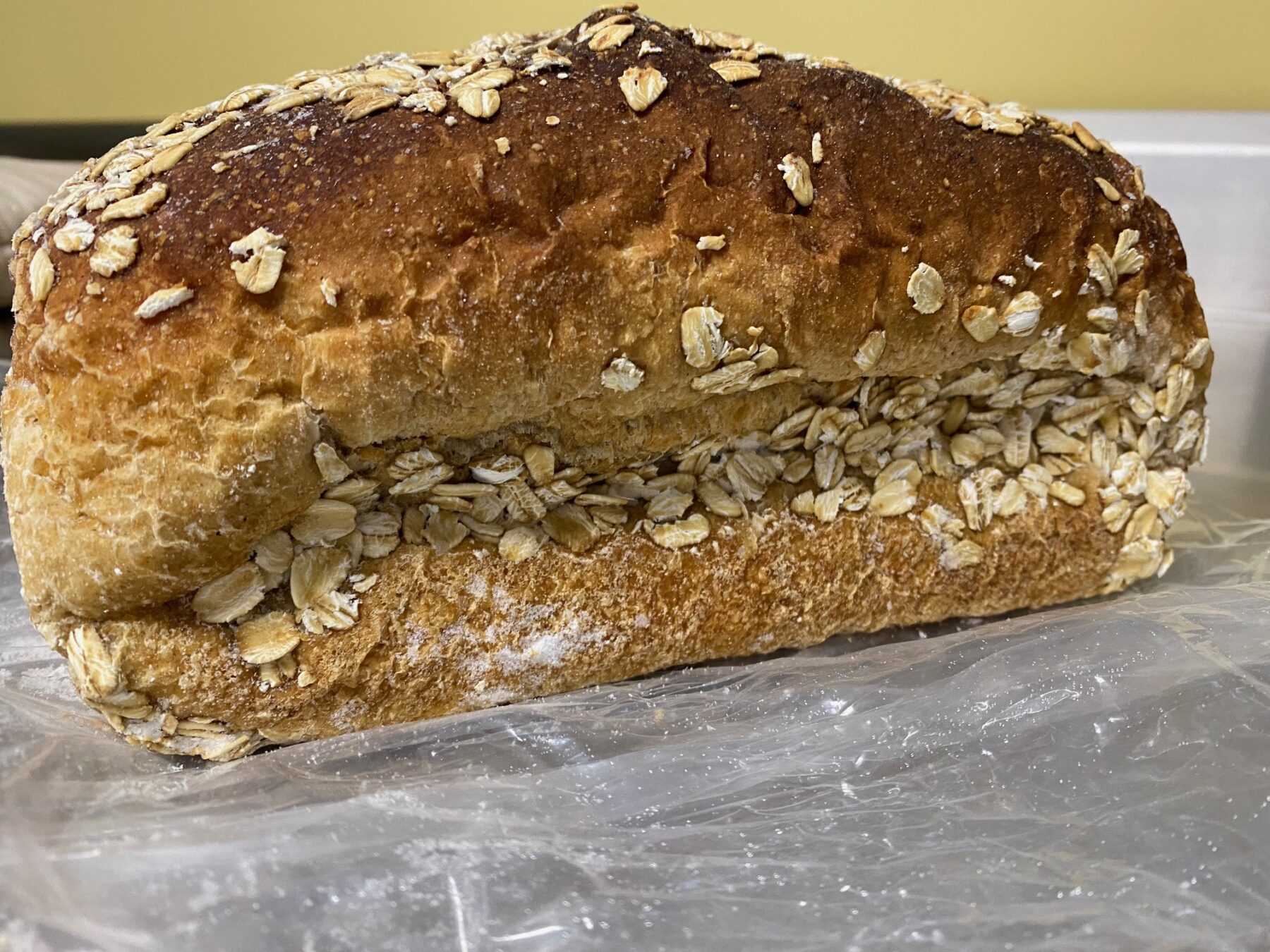
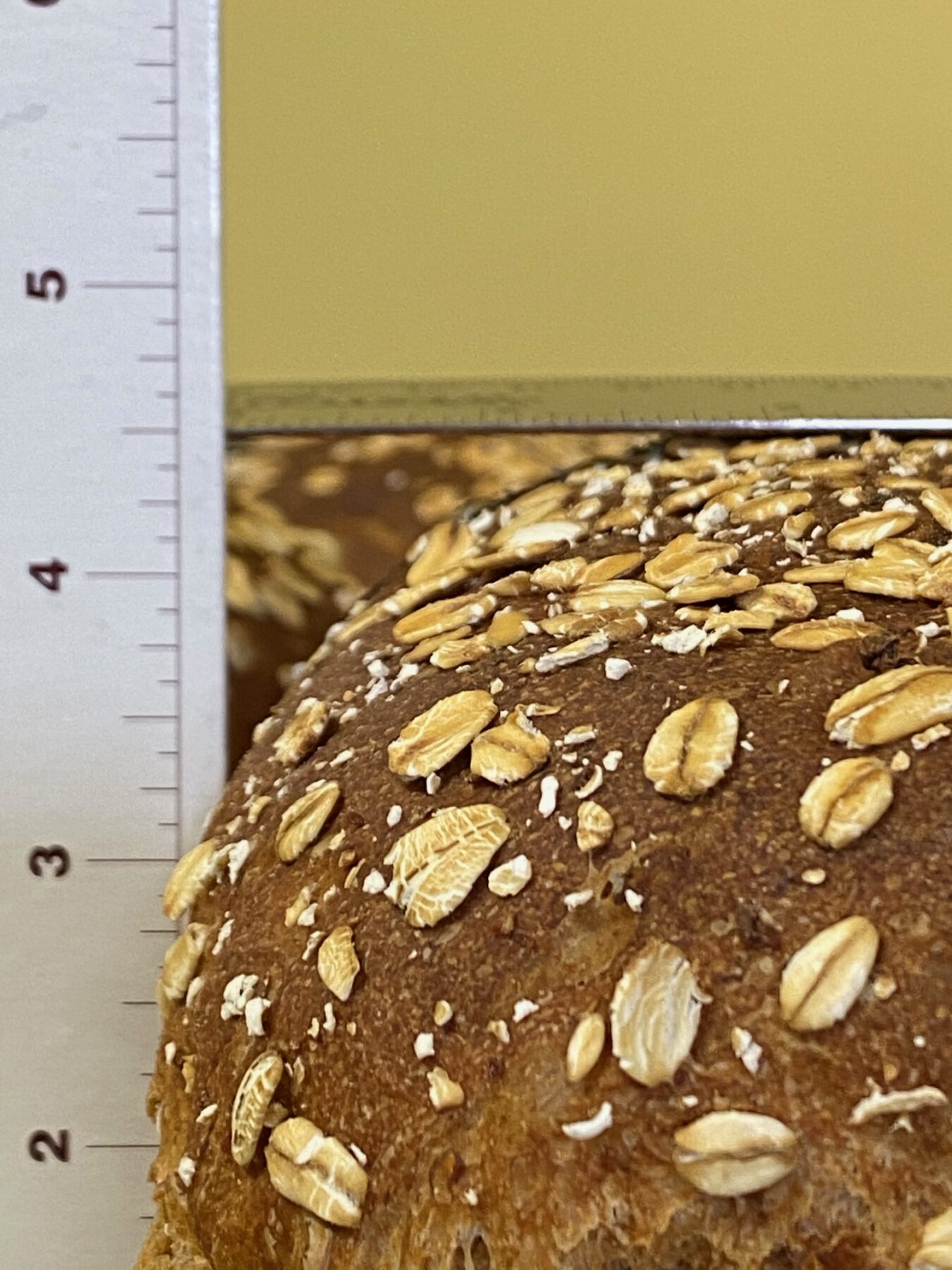
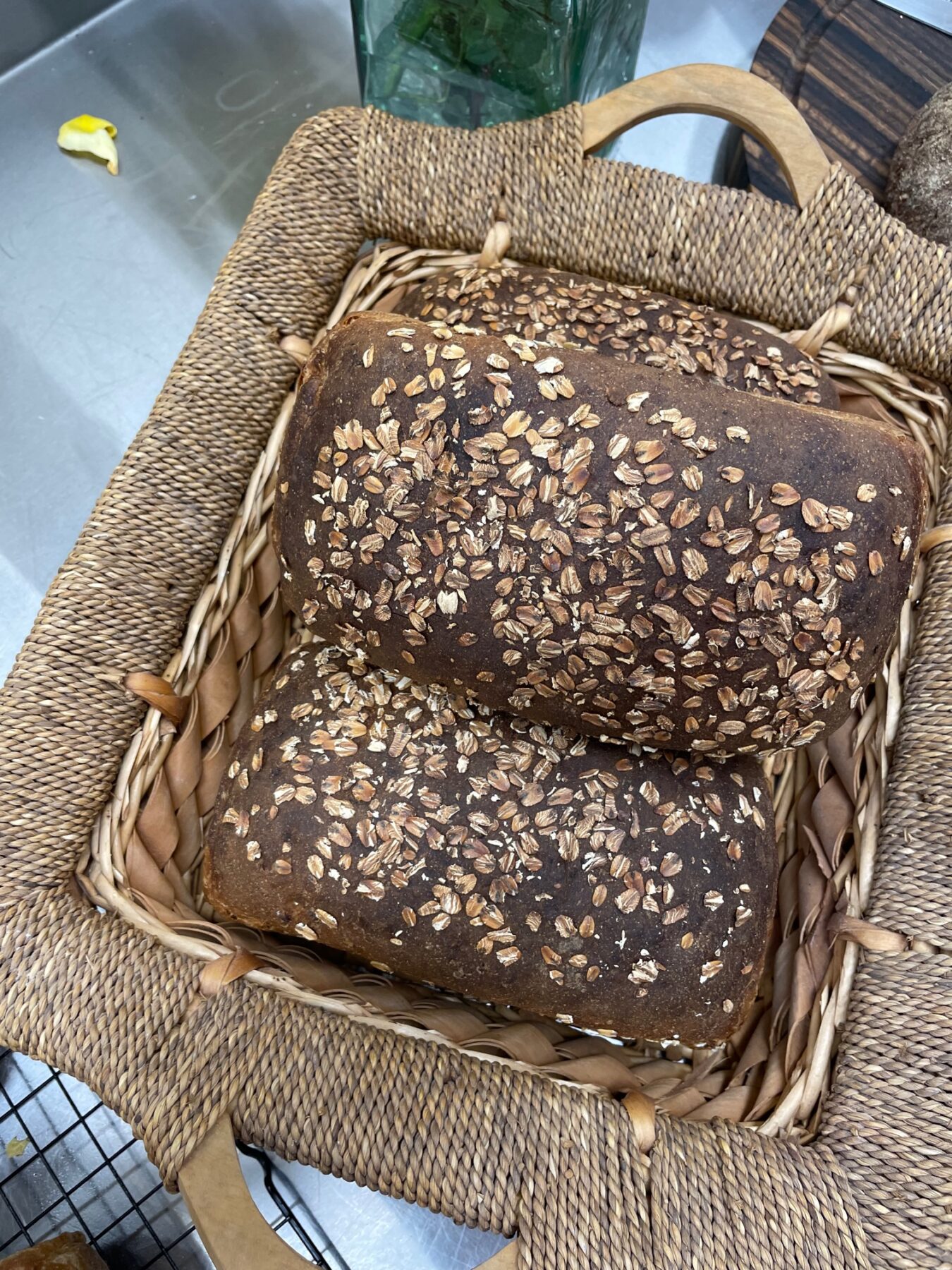
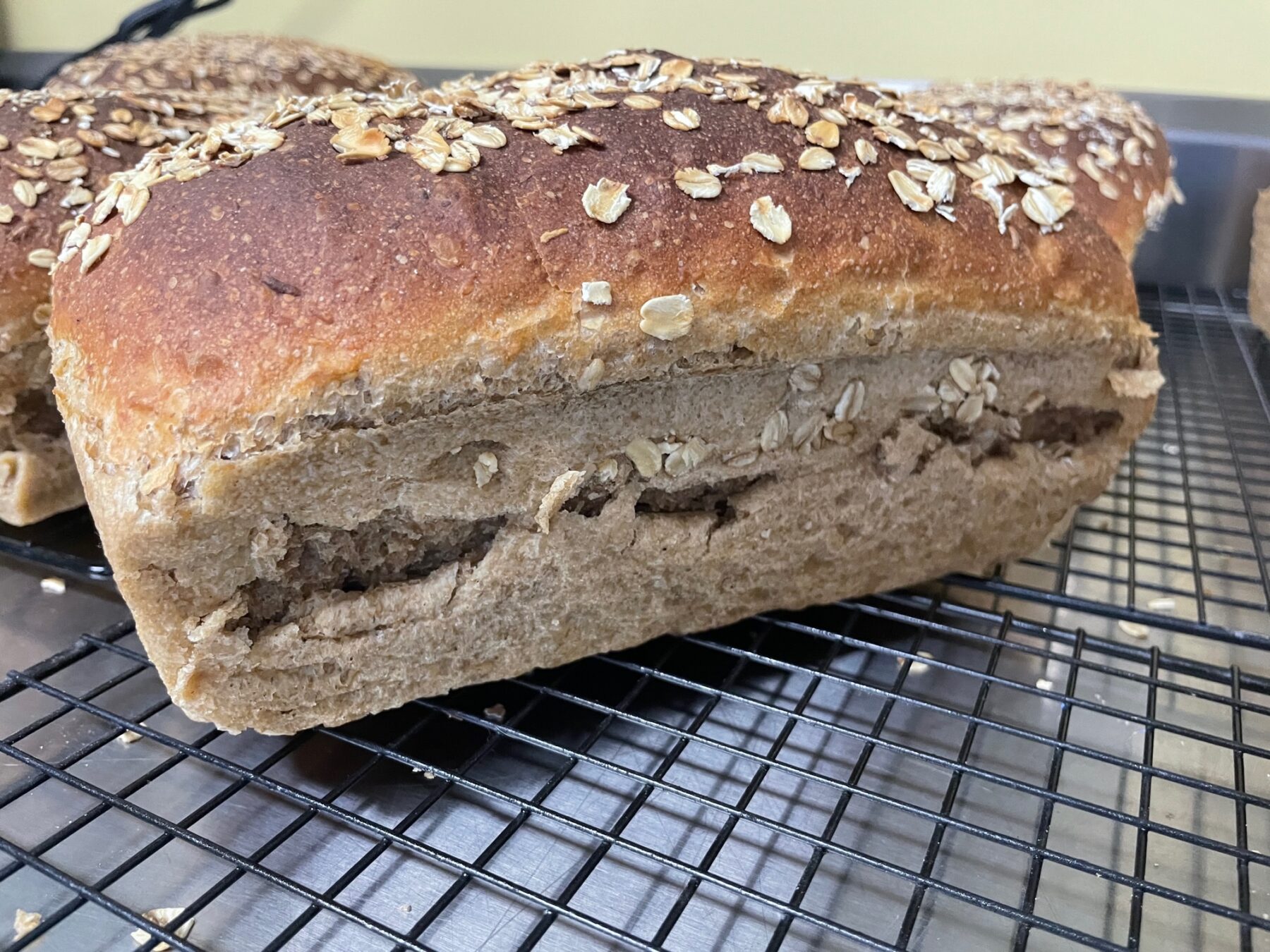


On your Dashboard, you’ll find a Calendar icon (see below). We list all of our program events on this calendar, from delivery days, to donation days, to food bank tours, and so on.

If you hover over an event on the calendar, you will see a pop-up box with more event info. Clicking on an event will take you to its full information page, with its location, time, and volunteer sign-up link (if applicable) listed.

Leave a Reply
The great thing about Community Loaves is that you can literally bake whenever it works for your personal schedule, as long as you have access to a freezer.
However, if you don’t have access to a freezer or freezer bank, then you are a Saturday baker. You’ll want to bake on Saturday, package the items on Sunday (which provides plenty of time for loaves and cookies to cool), and then transport them to your designated hub.
Otherwise, you can bake any day of the week that suits your schedule. You’ll still package these beauties up the next day after they’ve had plenty of time to cool (see our Packaging and Freezing guidelines). Then pop the packaged items into your freezer or get them to a freezer bank. What’s a freezer bank? Learn more here.
Leave a Reply
Yes, absolutely, you can still donate those items.
Now, having said that. If you can tie a string around your finger and remember to pre-check for the future, that would be very helpful. Pre-checking your donation is a real courtesy to your hub manager. It makes easy work for them to submit the final counts on donation Sunday. Here is a reminder of our pre-check process.
When you pre-check your donation, it is automatically listed on a printed sheet, placed on a clipboard, and you can simply scribble your initials and dash. No paper bag with your name is needed. Further, it is much easier for a hub leader to estimate the number of bins/boxes to put out. Rest assured, even if your count changes between the pre-check and the physical donation, as when a spouse unexpectedly cuts into one of the loaves, you can easily make a note on the printed check-in sheet.
Baking and donating is wonderful. Baking, pre-checking, and donating is divine!
We have great systems but sometimes we humans miss something!
If you don’t see your recent donation on your volunteer profile, it could have been missed in the final number count submitted by your hub leader. To prevent this from happening it is a good idea to pre-check your donations prior to a Sunday donation. But, even then, this can happen and it is easily remedied.
Send a quick email to your hub leader apprising them of the missing numbers and they can submit an edit to the count. Once that edit has been entered by the hub leader it takes 24 hours for update to take place.
Our Flour Fundraiser - Ordering Supplies (6)
To support our baking efforts, we run a monthly flour fundraiser. This fundraiser gives our volunteer bakers a lovely discount on high-quality professional flours and allows our 501c3 non-profit organization to thrive! Like a sourdough starter, regular “feedings” help to fund our growth and development. Check out our offerings and place your order here. You can also find a link to order supplies on your dashboard.
Locally, meaning in the greater Seattle area, we have a delivery service once a month. This takes place roughly the third week of each month. And the dates can be found on our program calendar. In order for our volunteers to have enough time to prepare for each delivery event, we turn the store off three days before we have to pack flour and load the truck. It is a good idea to order your supplies as soon as you know you need them.
We also direct ship some supplies to our baking friends and chapters in Idaho, Oregon, and California.
In all cases, we strive to keep this program accessible and affordable to the best of our ability while ensuring we can support our food banks for years to come.
Leave a Reply
For our extended outreach to areas like Boise and Hailey, ID, Southern Oregon, and all of California, we offer direct shipping of supplies. There is a limited number of essential supplies that bakers need to be successful. Once ordered, they will be directly shipped.
Items available for order include the following:
Here is some helpful information on our direct shipping practices:
- Your order, once placed, will go out via UPS or USPS.
- Monday is our shipping day
- Once shipped, you can expect to receive your order within 2-4 business days.
- The choice of UPS or USPS for us is a financial one; we’ll ship based on the lowest cost. However, there are instances when you may need a specific carrier. A good example is if you have a PO Box address. Although the option to select is not available at check-out, you can send an email to orders@communityloaves.org after you’ve placed your order, requesting us to use your preferred carrier. When sending that email it is most helpful if you include your order number
If you live in Western Washington or Northern Oregon, you will pick up your order at your designated hub location. If you are in the Greater Seattle Area, you may also place orders for pick up from Flour Central in Kirkland; we are open every Tuesday from 10m-4pm. We do not direct ship to these areas at this time.
At any time, if you have questions regarding your order or direct shipping, reach out to orders@communityloaves.org
Leave a Reply
If you want to view your previous Flour Fundraiser orders, it’s very easy to do so! Simply follow the steps below:
Step 1: On your Dashboard, click on Profile

Step 2: Scroll down to the bottom of the page, and you’ll see the Order History Section. Click “View” on the line of the order you’d like to see

Step 4: Voila! There it is.

Have any questions? Please reach out to bakersupport@communityloaves.org.
Leave a Reply
On your Dashboard, you’ll find a Calendar icon (see below). We list all of our program events on this calendar, from delivery days, to donation days, to food bank tours, and so on.

If you hover over an event on the calendar, you will see a pop-up box with more event info. Clicking on an event will take you to its full information page, with its location, time, and volunteer sign-up link (if applicable) listed.

Leave a Reply
To support our baking efforts, we run a monthly flour fundraiser. This fundraiser gives our volunteer bakers a lovely discount on high-quality professional flours and allows our 501c3 non-profit organization to thrive! Like a sourdough starter, regular “feedings” help to fund our growth and development. Registered volunteers can easily access our online shop for the purchase of essential supplies for the items we bake and donate to our food bank partners.
But, if you aren’t a registered volunteer, and are concerned about having time to bake with us, you can support the mission of Community Loaves and your baking habit at the same time. Every Tuesday from 10:00 – 4:00 pm, our Flour Store is open for drop-in visits. We’re located at 8730 122nd Ave NE, Kirkland. Here, at Flour Central, you can purchase freshly milled flours from the Skagit at a discount to retail, as well as a few specialty flours typically available to professional bakers only. If you have questions on availability, send us an email at bakersupport@communityloaves.org.
In all cases, we strive to keep this program accessible and affordable to the best of our ability while ensuring we can support our food banks for years to come.
Leave a Reply
If you are trying to place an order you might receive a pesky credit card notification that suggests your card is invalid. A particularly useless message when you know full well that your card is valid. We believe we have resolved this issue on our end, but if you encounter it, please try the following workaround – the goal is to make your browser forget what it might have previously saved.
If you use a Chrome browser, hold the Ctrl key down and click the reload button, which looks like this: 
If you use a Firefox browser, hold the Shift key instead and, again, click the reload button: 
Or, on Safari on a MacBook, press these keys at the same time: CMD + OPTION + R
If problems persist, reach out to us at orders@communityloaves.org or bakersupport@communityloaves.org. We have people at the ready to assist.
For ease, efficiency, and to prevent additional confusion, avoid sending these issues to your hub leader. Their role as program coordinator and cheerleader does not include troubleshooting CL baker website issues. It is much swifter when we can communicate directly.
Leave a Reply
Packaging and Freezing (3)
The great thing about Community Loaves is that you can literally bake whenever it works for your personal schedule, as long as you have access to a freezer.
However, if you don’t have access to a freezer or freezer bank, then you are a Saturday baker. You’ll want to bake on Saturday, package the items on Sunday (which provides plenty of time for loaves and cookies to cool), and then transport them to your designated hub.
Otherwise, you can bake any day of the week that suits your schedule. You’ll still package these beauties up the next day after they’ve had plenty of time to cool (see our Packaging and Freezing guidelines). Then pop the packaged items into your freezer or get them to a freezer bank. What’s a freezer bank? Learn more here.
Leave a Reply
We’ve learned that not all freezers are the same. Some are wetter/warmer than others. Ice caps can develop in the freezer and moisture can get into the packaging. The best tip/trick we’ve learned for this situation is to double bag the bread; this appears to eliminate the issue. On donation day: take the bread out of the freezer, remove the outermost wrapper, and keep that for the next round of packaging.
Another suggestion is to place the loaves in an insulated shopping bag (like those used to transport ice cream home from the grocery store). In this case, you only need one plastic bag, just place the packaged loaves directly in the insulated bag and then pop it in freezer. This is also a beneficial practice for the cookies, as it helps them stay as fresh as possible.
Let us know in the comments if this helps, or if you have another tip to share.
Hi Robin, great question! When baking any day other than Saturday, please freeze your loaves. Even a short freeze will extend their shelf life. I’ll be sure to add this information to our FAQs; thank you so much for asking!
when should i freeze bread? if i bake on Fri for Sun donation, should I freeze it? is there a cutoff on how long between baking an donating fresh?
Leave a Reply
Preserving the fresh-baked quality of your loaves and cookies in a safe manner is of the utmost importance to our program practices.
- Cooling
- Thoroughly cool loaves and cookies to room temperature before packaging. This prevents unwanted condensation from collecting inside the packaging as the item cools, which can lead to mold or spoilage.
- In the early days, same-day bakers would package the loaves while they still had a little heat and that created steam in the bags…which could potentially lead to mold.
- In an abundance of caution, the standard recommendation is to let them cool overnight. But in fact, 5-8 hours should be sufficient.
- Packaging
- When items are completely cooled, use kitchen tongs or a gloved hand to place in the bag.
- For the bread loaves, squeeze out as much air from the bag as possible, then twist tie tightly closed. Watch our bread packaging video in baker resources if you have questions.
- For the cookies, fold the top of the wax bakery bag over and affix a sticker over the flap to seal. Watch our cookie packaging video in baker resources if you have questions.
- Freezing
- If baking any day other than Saturday, place the packaged items in your freezer until donation day, or a drop in a freezer bank. Even if you bake on Friday, go ahead and freeze your items, as even a short freeze will extend their shelf life.
- When transferring for donation, simply remove the baked items from your freezer and insulated bag and take them to your desired drop off location.
Let us know if you encounter issues with packaging your baked items, or if you have tips for your fellow bakers, in the comments below. Take a quick glance at the FAQ below, Troubleshooting Freezer Issues, for more.
Hi Cheryl,
Running out of packaging occasionally happens. If you aren’t able to come by our Flour Central offices to pick up extra supplies on a Tuesday, it is possible for us to ship. The price of postage would be included in the invoice we create for you.
To have packaging shipped to you please email orders@communityloaves.org; we ship orders every Tuesday.
I only have 20 bags for bread left. Is there anyway to get me some bags before the 23rd? I can pay for postage or my husband can come get them as a last resort. I bake a lot of bread and am going through a lot of bags.
Leave a Reply
Recruiting Bakers (1)
We have designed some lovely marketing tools for you to help grow your hub! Here’s how to find flyers that you can share to help let folks know what we’re up to, and how they can join our baking brigade. Follow the steps below to get your hub’s customized flyers for printing at home.
Step 1: Click on “Your Hub” on your Dashboard
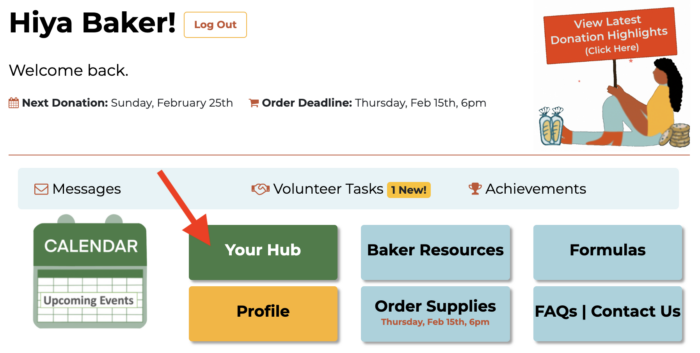
Step 2: Clock on “Grow Your Hub”

Step 3: In the Outreach Kit section, click on “Download”
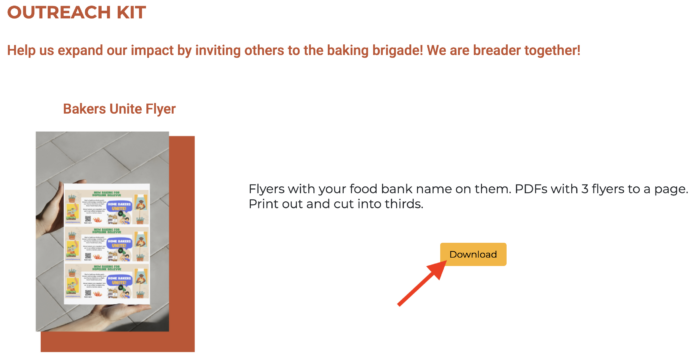
Step 4: To view an alphabetical list of hubs, click on the three lines (vs the four dots) icon at the top right corner. Then scroll to your hub name and double click on it to open and view the file.

Step 5: Click on the three dots to open the menu, and then click on “Download” to save to your computer. You can also click on the printer icon to print directly from this page.
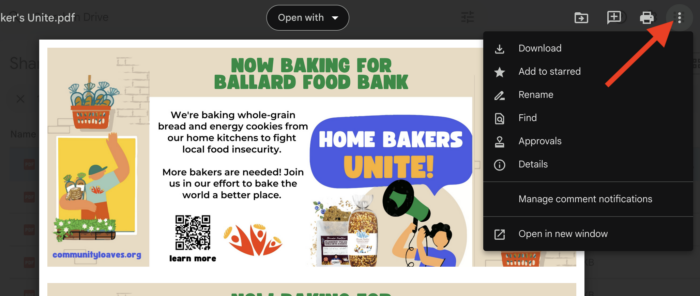
Leave a Reply
Start an Effort in Your Neighborhood (2)
This is one of our favorite questions!
Launching a new Community Loaves hub is a noble calling. You are building the foundation for supplying a local food bank with freshly baked, nutritious bread and energy cookies. All from the home kitchens of volunteer bakers. Being a hub leader is a rewarding volunteer effort helping to build community and providing logistical support to our twice-a-month donation effort. It isn’t hard, usually 10-15 hours a month, much of that “passive” time. Getting a new hub established does take a few steps.
First – If you haven’t attended a New Baker Information Session, please do this first. This provides the foundation for why and how we do the things we do. Find a date that works for you.
Second – Sign up for a New Hub Leader training session. This one-hour zoom session will provide the training and logistics for hosting a hub. If none of the upcoming sessions work for you, or there are no upcoming sessions posted, please email info@communityloaves.org, and we will work to establish a session date.
Third – If a food bank partner is needed in brand new geographic areas, we will work together to secure that partnership.
It might take a couple of months to assemble the pieces depending on our mutual availability. (This is mostly waiting and back-and-forth time for the next step.)
Leave a Reply
Have an extra freezer? Want to become a drop point for donations? Freezer banks allow bakers to drop off their donations at times outside of the usual Sunday donation day: easier for those with unconventional schedules, or when vacations or other responsibilities interfere with a Sunday drop off.
As the freezer bank manager, you will be responsible for making sure that the loaves and cookies donated to your freezer are transferred to the food bank for the next donation date. This might mean bringing them to your hub along with your own donations on donation Sunday, or it might be that you drop them off yourself at the food bank Monday.
Still interested? Send us a message and we’ll get back to you soon!
Support and Motivation (2)
Sometimes it is hard to know what to say in the twice-a-month cheerleading for your hubs. Here are a couple of emails that could serve as inspiration.
From Sandy Merrit-Shea to her hub leaders, following a recent donation:
Good Morning Bonney Lake Hub Bakers!
This Sunday, the 25th, is donation day. So get those bread loaves and Energy Cookies ready to be dropped off! Here is the info: 18402 139th St E. from 9 am – 5 pm. Donation bin on the front porch w/signup sheet on a clipboard.
Remember to record #’s today on the website, too. The Bonney Lake Food Bank will be closed on Monday the 26th, so I will deliver to them on Tuesday. If you would like to drop off donations to the hub on Monday, to keep everything frozen one more day, I will be here. Whichever day works best for you, Sunday or Monday, just text me if you would like to drop off on Monday.
Let’s welcome our newest bakers to join our baking brigade, Julia Osborne and Amy Vandenberg! We are all so happy to have you with us on this journey to provide for our community; the Bonney Lake Food Bank thank you!
We also have some One Year Anniversaries to celebrate. Let’s give a round of applause to Gretchen McCallum, Wendy Adams, Amanda Kruger and Glenda Brown! Thank you, Ladies, for helping to build our little hub into what it has become, I’m in awe of you all…Thank you!
It would be great to have everyone upload a picture on your profile page on the Community Loaves website. Always so nice to have a face to go with your name, and I’ve even seen some of you out in the community, I love that!
We truly are Breader Together!
Sandy Merritt-Shea, Bonney Lake Hub Coordinator
We have a new tool that allows you to send a quick note or an animated card to a baker, or your whole hub. SO fun! However, this is different from our email tool, and it looks like this:

Here’s how it can be accessed:
-
- Click “Messages” in the blue bar at the top of your Dashboard. This will take you to the page view seen above. If you have a new message, a notification will show up next to “Messages” (just like you can see “4 New!” next to Volunteer Tasks, below).

2. Click on “View Latest Donation Highlights”

This will take you to the Donation Highlights page, where you can view organization totals, baker anniversaries and badges earned, and hub specific numbers for any donation date you choose from the drop down menu. You can toggle between Organization Totals and View My Hub Only to change what you’re seeing on the page.
Tabs allow you to view the names of bakers who are celebrating anniversaries, or have earned specific badges during the donation date chosen. Click on the green “Say Congratulations” button next to a baker’s name.

3. Access a list of all your hub members from the Your Hub button located on your main Dashboard.

Then scroll down to the grid of friendly faces, and click on the little red envelope icon. This will take you to the messaging tool and you can choose a card to send, or just send a quick note.

Leave a Reply
Trouble Shooting - Bread (9)
Cairnspring Mills recently (early summer 2023) modified their Trailblazer flour which is used by our greater Seattle area bakers to a blend. This blend doesn’t have the same enzymatic activity as the previous version. As a result, we recommend adding 2g – 3g of diastatic malt per loaf to the autolyse step.
Below is the email sent to our bakers on Saturday, July 22nd.
This email is an update on a “rising” issue many are experiencing, including myself, with our bread bakes over the past 3-5 doughnations.
I think we’ve finally cracked the code. It seems to result from the shift in the Trailblazer flour, which is now a blend of wheat vs a single varietal of Yecora Rojo. This new blended TB flour has a higher falling number (FN), one of the metrics flour manufacturers often test for future bread performance. The WSU bread lab has a machine that runs the Hagburg Falling Number test.

The machine at the lab, looks roughly like the above. It is used to measure the enzyme activity in flour. The FN (Falling Number) of flour is related to the amount and activity of cereal enzyme α-amylase, which is present in wheat after harvesting.
The FN is the time in seconds required for a device to fall a measured distance through a hot flour/water mixture while heat is applied. (Literally tracking the speed of a plunger through the slurry.) If the enzymatic activity is high, the starch is rapidly broken down (liquefied) during gelatinization. So then, the device falls through the relatively liquid paste in a short time. A less viscous fluid opposing less resistance to the flow means the FN is low. On the other hand, if the enzyme’s activity is low, it takes longer for the device to cover the distance of its fall. This means the falling number is high. See the Test
Which brings us to our current Trailblazer.
I do not know the exact falling number for our current TB, but it is reportedly HIGH by Mel Darbyshire, executive baker at Grand Central, who purchases silos of the stuff. And in the shop, meaning at Grand Central, they compensate for the higher falling number, lower enzymatic activity by adding diastatic malt. Diastatic malt vs nondiastic malt the first is cured at low heat and still has its enzymatic properties; nondiastic is mostly lovely sugars we like for browning.

If you are experiencing problems with your loaves, they aren’t rising like they used to, a little Diastatic Malt Powder is your friend. It might be difficult to find at your local store, but you can get it at Amazon, King Arthur, Web Restaurant, and other suppliers.
A little goes a long way. And there is a lot of information on the web. I recommend adding the diastatic malt powder at the beginning of the autolyze phase; you can also add it during the mix if you prefer. How much to add? The range is quite significant: Diastatic malt should be added to the total flour weight in the range of 0.5 to 2%. One loaf is approximately 600g; let’s start at .02%, which would be 3 grams per loaf; making 4 loaves, you’ll want to add 12 grams. Easy math and reasonable assurance for better activity.
There is a lot of information on making your own diastatic malt, for all you DIY’ers. Here is one source for the process: The Fresh Loaf. Another recent piece by talented baker & blogger Maurizio Leo – The Perfect Loaf – What Is Diastatic Malt
I’m so grateful we have a solution to this prickly problem; many of us were wracking our brains about why our near-perfect loaves were acting up. This is part of the issue. In addition, I will put the Organic Expresso to the test. It has a lower falling number and shouldn’t require the diastatic malt. I will also check with Cairnspring to understand whether the current FN issue will be persistent or seasonal. This is freshly milled wheat and flour and part of the ongoing variables that professional bakers manage. We’ve been blessed with so much consistency that it caught us a bit flat-footed, and flat loafed!
Back to FN & Diastatic Malt – Some of you may not have any issues. So this can be a tool in your toolkit down the road. For those of you who are, I’ve shared the beginning of the breadcrumb trail. Some of you will go quite deep down this rabbit hole, and I look forward to hearing from you and your continued learning.
2023-08-16 UPDATE:
Feedback from bakers using the new flour is that the diastatic malt has indeed done the trick. Loaves are back to standard heights.
Hanne, this is a great question and I’m sorry for the delay. We are recommending a small amount of Diastatic Malt to TB even if purchased May 2023. It shouldn’t hurt and it might help if it is the “blended” version. We’re in conversations with Cairnsprings right now to understand the future disposition of the flour. We will keep you posted on those conversations.
Do I need to add diastatic malt to TB received with the May 2023 order? Thanks.
Checked on the shelf life of Diastatic Malt Powder. Dr. Google says it’s about a year, and that can be prolonged by keeping it in the freezer.
We talked about using Diastatic Malt today during the baker debrief. Several bakers reported better success with a smaller amount of diastatic malt 2 to 3 g per loaf you are baking. Give this a try and report back.
Leave a Reply
Crystals Happen!
If it’s been a while since you last used your honey, you might find it has separated or crystallized. According to Master Beekeeper and President of the Puget Sound Beekeepers Association, Dawn Beck, this is a naturally occurring property with honey and is a simple result of water pulling away from the sugar solution. This “separation” results in a crystallization of the remaining sugars.
But you don’t need to pitch that jar of honey. Instead, there is an easy way to reconstitute those crystals! This tip from Dawn, “Turn on your oven light, place your jar of honey in the oven, and leave it overnight (no heat required!). By morning, your honey should have returned to its liquid gold state and be ready to use.

Let us know how this works for you? Have another idea, share in the comments below?
Yeast Doesn’t Live Forever
If you suspect that your yeast might be past its prime, you can easily check this out: you’re going to “Proof” the yeast. Follow these instructions:
1. Place some warm water in a cup, say 1/4 cup. Aim for around 100–110 degrees Fahrenheit. Avoid going above 120 degrees, as you’ll begin to damage the yeast at this point. At 140 degrees, you’ll kill the yeast.
2. Mix in yeast (2 1/4 tsp) and sugar (1 tsp) to the warm water. Give a little stir, a small whisk is helpful; this “action” agitates and helps the yeast react. Leave the mixture for 10 minutes. Upon return, if you have a foamy and creamy looking concoction on top, your yeast is still active and good to go (see picture below).

Resources: Masterclass, FoodNetwork, The Spruce Eats
Need yeast? Order from our Flour Fundraiser Store!
Leave a Reply
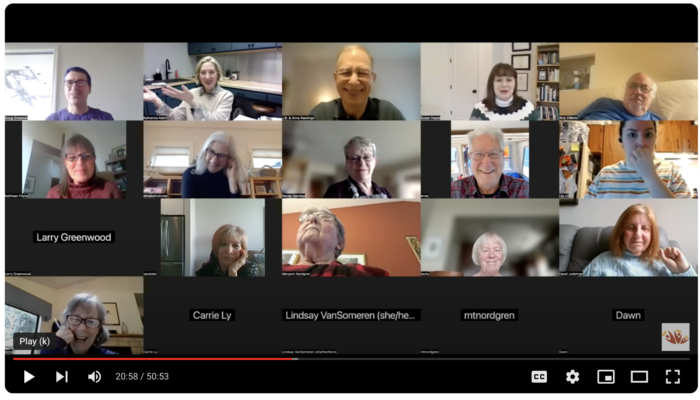
Twice a month, we host a live Zoom session just to talk about baking. It frequently begins with questions and troubleshooting—about loaves and cookies—and attendees share any challenges and lightbulb moments. No two sessions are identical, and some attendees are frequent guests enjoying the ability to share new optimization techniques or other efforts they employ to be a better baker. It is wonderful when we have a mix of new bakers and deeply experienced CL Bakers.
If time allows, during the 1 hour session, we open up the discourse to initiatives at Community Loaves, new formula development, and new programs we want to launch, and it is so wonderful to get to know more people within this Breader Together organization!
Typically, the baker debriefs occur on Tuesday at 12:00 noon, following a donation on Sunday. These “events” are listed on the program calendar and include the Zoom link—and here is the Zoom Link – Passcode “Bread4All!” as well!
We hope to see you soon! Please provide feedback in the comments section if you would like to see additional or different time options offered for the Baker Debrief.
Leave a Reply
Sometimes, loaves come out of the oven gorgeous, beautifully browned, and perfectly domed, only to collapse as they cool. Or perhaps they burst open with a side or top split. It’s a common baking mystery we’re here to unravel.
It gets down to gluten development and under- or overdevelopment.
When gluten, which is like a rubber band, is “underdeveloped,” the pressure of the quick expansion in the oven heat can “snap” the gluten at its weakest point, leading to “splits.” The solution can be a combination of any of the following: longer mixing time to assure good gluten development, a little longer bulk ferment for the same reason, and really the first one to try, a longer proof. How much longer? It’s hard to tell, but start with a little longer and test using the poke and jiggle tests.
What about “overdeveloped”? It’s similar but the opposite. When the gluten, like a rubber band, has been overstretched, bread comes out of the oven looking beautiful but collapses because the “rubber band” structure can’t support the “dough.” The gluten folds into itself.
Leave a Reply
My loaves didn’t turn out as planned, can they still be donated? We’ve received scores of inquiries with pictures asking this very question. Not all loaves are Instagrammable, but often, they can still be donated!
Divots and dimples are a sign that your loaves are slightly or greatly over-proofed. Generally, they aren’t as attractive as that beautiful domed loaf, but they sure are tasty and definitely worthy of donation. What about underproofed loaves? The telltale signs of a split at the sides or top again make the loaf a little less attractive but certainly donatable.
OK – what about loaves that are too dark, too short, or just really don’t look like a loaf? Well, now we have a challenge. A good rule of thumb: would you enjoy the loaf as a family? If yes, donate it. If the answer is no, perhaps your kiddo might utter an “EWWW”, maybe that loaf is destined for the compost bin. Gratefully, flour is relatively inexpensive and you can try again. A loaf that is short and squat, looks like a brick, well that is probably not the loaf anyone will take at the food bank so keep it for yourself, make bread crumbs and start again.
Speaking of Starting Again: Consider attending a Baker Debrief session. The collective experience of the attendees will help you work the chinks out of your loaves. We can help you get from wonky to perfect in no time! All Baker Debrief sessions are listed on our volunteer calendar HERE.
Still unsure: Send us a snap of your funky loaf! We’re happy to give our two cents. Email us at bakersupport@communityloaves.org.
Sample images below, for reference purposes, may provide additional assistance.








We’ve learned that not all freezers are the same. Some are wetter/warmer than others. Ice caps can develop in the freezer and moisture can get into the packaging. The best tip/trick we’ve learned for this situation is to double bag the bread; this appears to eliminate the issue. On donation day: take the bread out of the freezer, remove the outermost wrapper, and keep that for the next round of packaging.
Another suggestion is to place the loaves in an insulated shopping bag (like those used to transport ice cream home from the grocery store). In this case, you only need one plastic bag, just place the packaged loaves directly in the insulated bag and then pop it in freezer. This is also a beneficial practice for the cookies, as it helps them stay as fresh as possible.
Let us know in the comments if this helps, or if you have another tip to share.
Hi Robin, great question! When baking any day other than Saturday, please freeze your loaves. Even a short freeze will extend their shelf life. I’ll be sure to add this information to our FAQs; thank you so much for asking!
when should i freeze bread? if i bake on Fri for Sun donation, should I freeze it? is there a cutoff on how long between baking an donating fresh?
Leave a Reply
Volunteer Tasks (1)
Great Hub Leaders Ask For Help!
Our Volunteer Task Tool exists to help you – plan ahead, easily request help from your Hub and automatically awards valuable donation time as a thank you for their efforts.
The Volunteer Tasks button allows you to create volunteer tasks whenever you need help. Watch the video below, or scroll down to see the step-by-step.
Step-by-step:
1. Once you have clicked on the Volunteer Tasks button, you can scroll down and click on “Create Task.”

2. In the “Task Title” field, select from predefined tasks or create your own by selecting Custom.

3. Volunteer tasks automatically record to the Volunteer Dashboard of your own hub. If you have affiliate hubs, you may select for them to also receive the sign up notificiation by checking the box next to their name at the bottom of the page. (see above)
** Tip: Once you’ve created a task, copy the link to it and share it with your entire hub, using our email tool, to encourage signup! **
Once the task is completed you will be prompted to acknowledge the time donation, which you can do at the top of the Volunteer Tasks page. Once time donations have been submitted, a thank you is automatically sent and the time is recorded on their profile.

You can also create a “Delegate” – great for hub management – they get all the tools! Learn more about delegates here.
Leave a Reply
What We Bake (3)
Our volunteers have the opportunity to bake and donate two different items for our neighborhood food banks. You can choose bread, energy cookies, or both! Or mix it up: donate bread one week and energy cookies the next. Both are whole grain, delicious, and equally appreciated by food bank clients. Each donation is your choice!
Once you have attended an information session and registered as a volunteer, you can download the recipes for either of our program bakes.
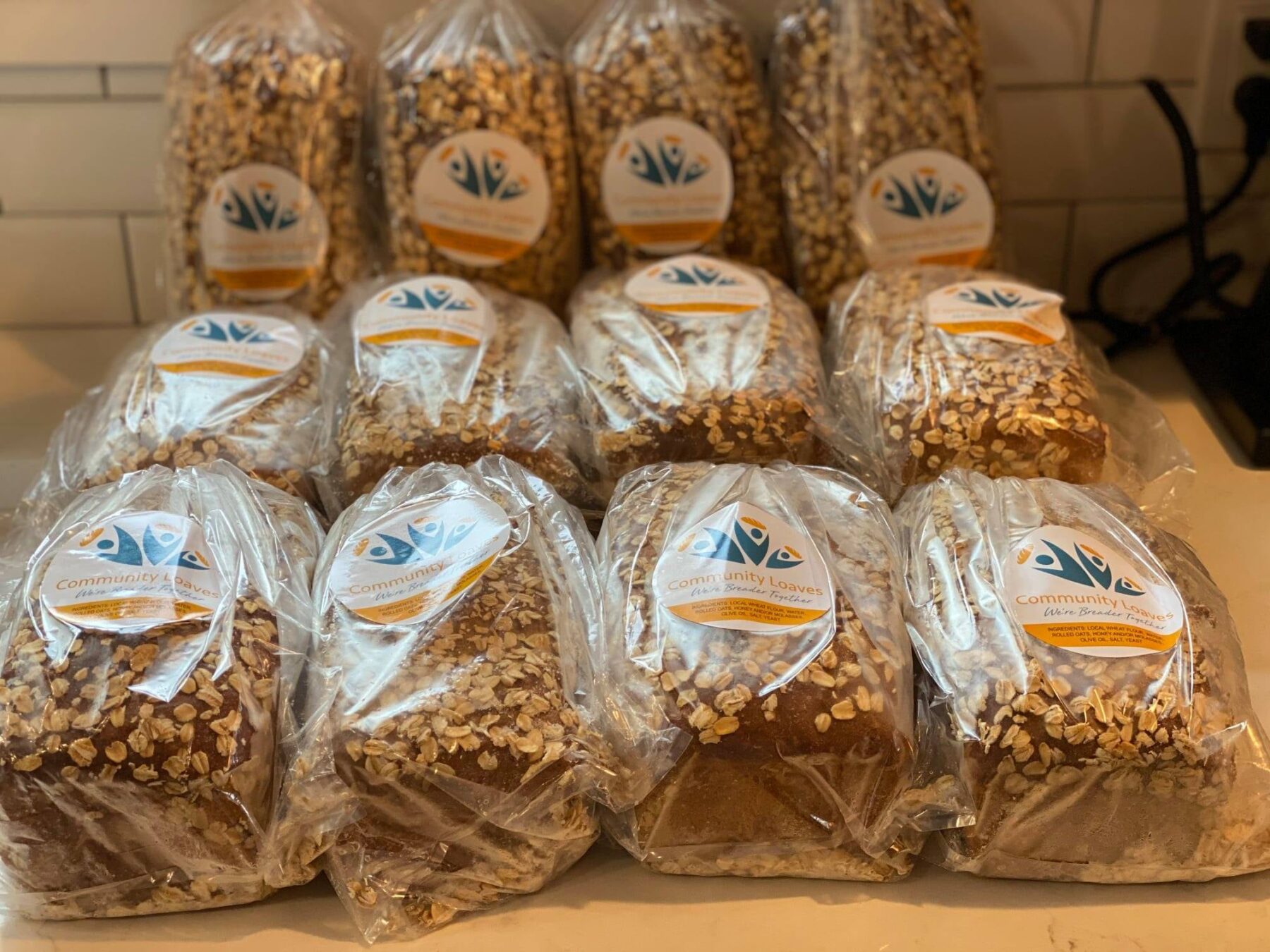
Our Signature Bread!
Our Honey Oat Sandwich Loaf recipe is available in multiple formats, spreadsheet or pdf, and multiple leavening options – meaning you can use commercial yeast or a natural starter. Folks rave about our bread. Home-baked bread is a time commitment, about 6-7 hours per batch. Batch size depends on your equipment, but generally bakers choose to make 3-4 loaves. Experienced dough-handling skills are not required; we support your journey every step of the way. These loaves are a terrific way to nourish our community.
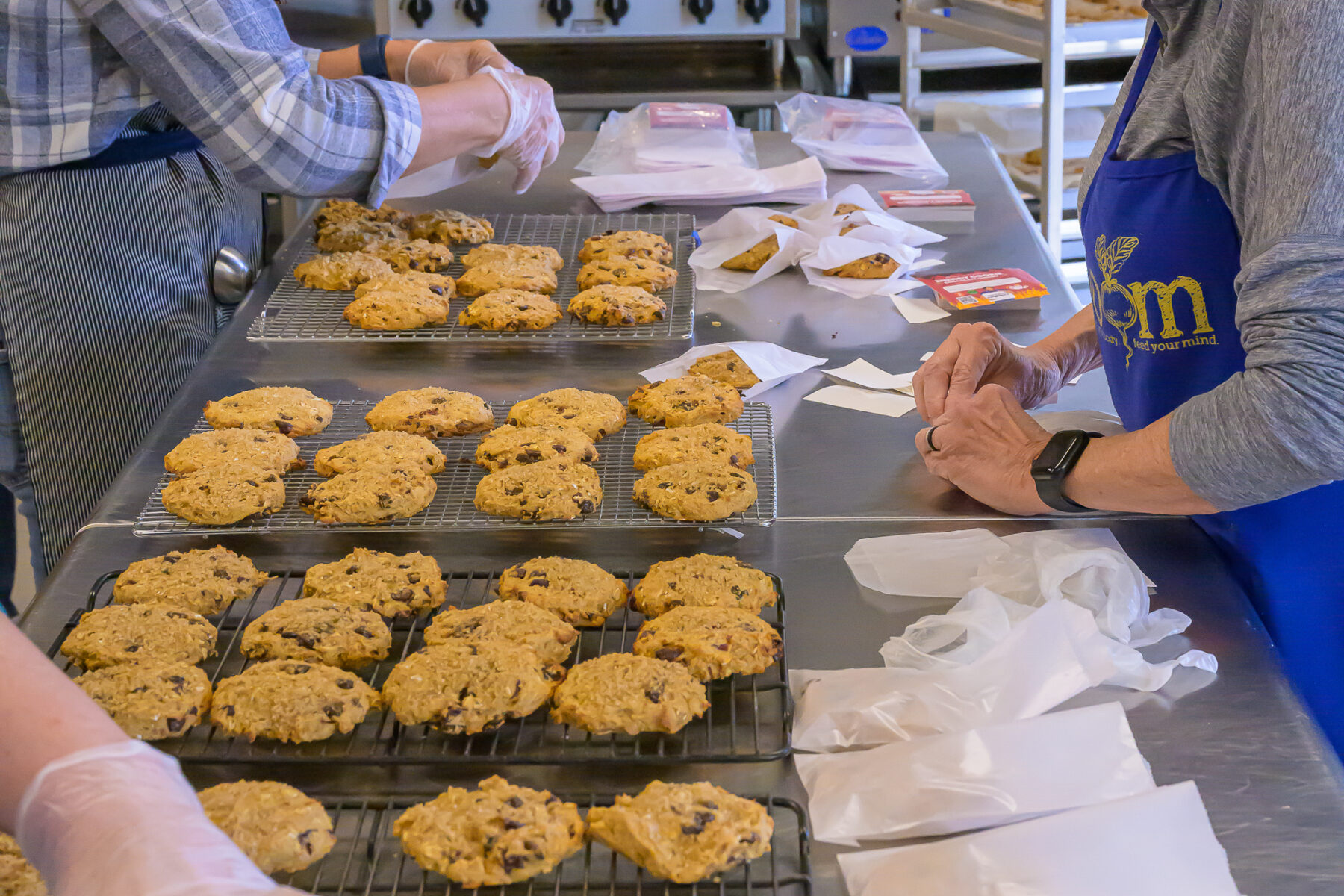
Our Grab ‘N Go Energy Cookies!
Find bread a little intimidating? Need something that takes less time, something you can mix in one bowl with a wooden spoon?! Our Grab ‘N Go Energy Cookies are a perfect match. Made with six nutritious whole-grain flours (pre-mixed by us, and available for purchase at our online shop), you can whip up a batch of 32 cookies in just a few minutes and complete the whole project in just a few hours of baking.
Have a question? Ask away in the comments!
Hi Darla,
Community Loaves program assistant here!
We found the Costco brand dried cherries on Amazon: https://www.amazon.com/Kirkland-Signature-Dried-Cherries-Ounce/dp/B07DBVGJ39/ref=asc_df_B004CSGRS0/?tag=hyprod-20&linkCode=df0&hvadid=693368766128&hvpos=&hvnetw=g&hvrand=4477611334006064271&hvpone=&hvptwo=&hvqmt=&hvdev=c&hvdvcmdl=&hvlocint=&hvlocphy=9033276&hvtargid=pla-568657547022&mcid=07758d01633e3ef4ac12a4285fb45fe4&gad_source=1&th=1
Hope this helps! Please let us know if you need any other sourcing help.
Hello, I am a newbie to the Community Loaves. I plan on making the cherry/choc chip energy cookies. Where are people buying the dried sour cherries? I have checked Costco & Target with no luck. Thank you!
Hi Ed, thank you for your question! Our bakers use a special mix they purchase through our shop to bake the cookies, following our signature formula. A lot of time and development goes into each recipe we donate to our partner food banks, as our items are designed to meet certain nutritional specs. It’s not so much a cookie as it is an energy bar in cookie form. You can find more details on the nutritional value of our Energy Cookie here: https://communityloaves.org/nutrition-facts/.
Your oatmeal-raisin-walnut-orange zest-cranberry-clove cookies sound DELICIOUS. We do plan to add to our mix of recipes, and if you would like to share, we will add it to our R&D.
in baking Energy cookies, are CL bakers restricted to a specific recipe? The reason I ask is that I make a great oatmeal-raisin-walnut-orange zest-cranberry-clove cookie and would like to share them with CL distribution.
In my food pantry box this week there were these amazing candy cane and chocolate bars 8 was wondering if the recipe was available. If it’s a large recipe I can reduce it to a smaller one no problem. The bars were so good my family wants me to make more. Happy Holidays and thank you
Penny, this is a delayed response to your question. Our apologies. We’re getting a new system in place. All the instructions for any of our donation items can be found under the formulas tab on your volunteer dashboard. I’ve added an image to the FAQ to help future bakers find the spot.
Carol – this is a greatly delayed response, but yes. Costco yeast is perfectly acceptable. We love it when our volunteers can support our monthly flour fundraiser through the flour store, but in a pinch purchasing these items elsewhere certainly works! Thank you. ~ Katherine
I noticed you sell yeast on your website. I buy yeast from Costco – is it OK to use this yeast instead?
I lost my step-by-step instructions.
Leave a Reply
We are big fans of local ingredients, and organic is preferred when it fits our volunteers’ budgets. We receive a lot of questions about if our items are whole grain, so here’s the scoop.
Our Honey Oat Sandwich Loaves are considered a whole grain loaf, but are really about 75% whole grain due to the blend of flours. They are made from 50% Whole Grain Bread Flour and 50% High Extraction flour. However, a few exceptions exist on the exact blend depending on local market conditions. For example, in Hailey, Idaho, we use locally milled, even higher extraction, Hillside Grain flour.
What about the Energy Cookie? The energy cookie is a blend of six different whole grain flours: whole grain pastry flour, whole grain oat flour, whole grain rye flour, oatmeal, whole grain chickpea flour, and almond meal (made using the whole almond!).
Leave a Reply

Every holiday season, Community Loaves donates a holiday treat box as part of the final doughnation effort of the year – it is our Baking Spirits Bright campaign. We know the holidays can be an especially challenging time, and an unexpected baked-from-the-heart gift can provide a little lift to one’s spirits.
We hold a little competition every fall. The winning recipe gets baked, packaged, labeled, and donated to our partnered food banks. In 2023, we had 19 contestants submit tasty recipes, and 16 volunteer judges tackle the challenging task of selecting the top cookie. Kirkland Juanita hub volunteer baker Anna Fine, is the creator of the 2023 winner. Her Holiday Shortbread Squares are easy, festive, and oh-so-delicious! As a gift to one and all, we are sharing the recipe with anyone who would like to whip up a batch. On Monday, December 18th, 2023 we donated 1947 treat boxes containing 16 cookies each.
The 2023 judges in action:
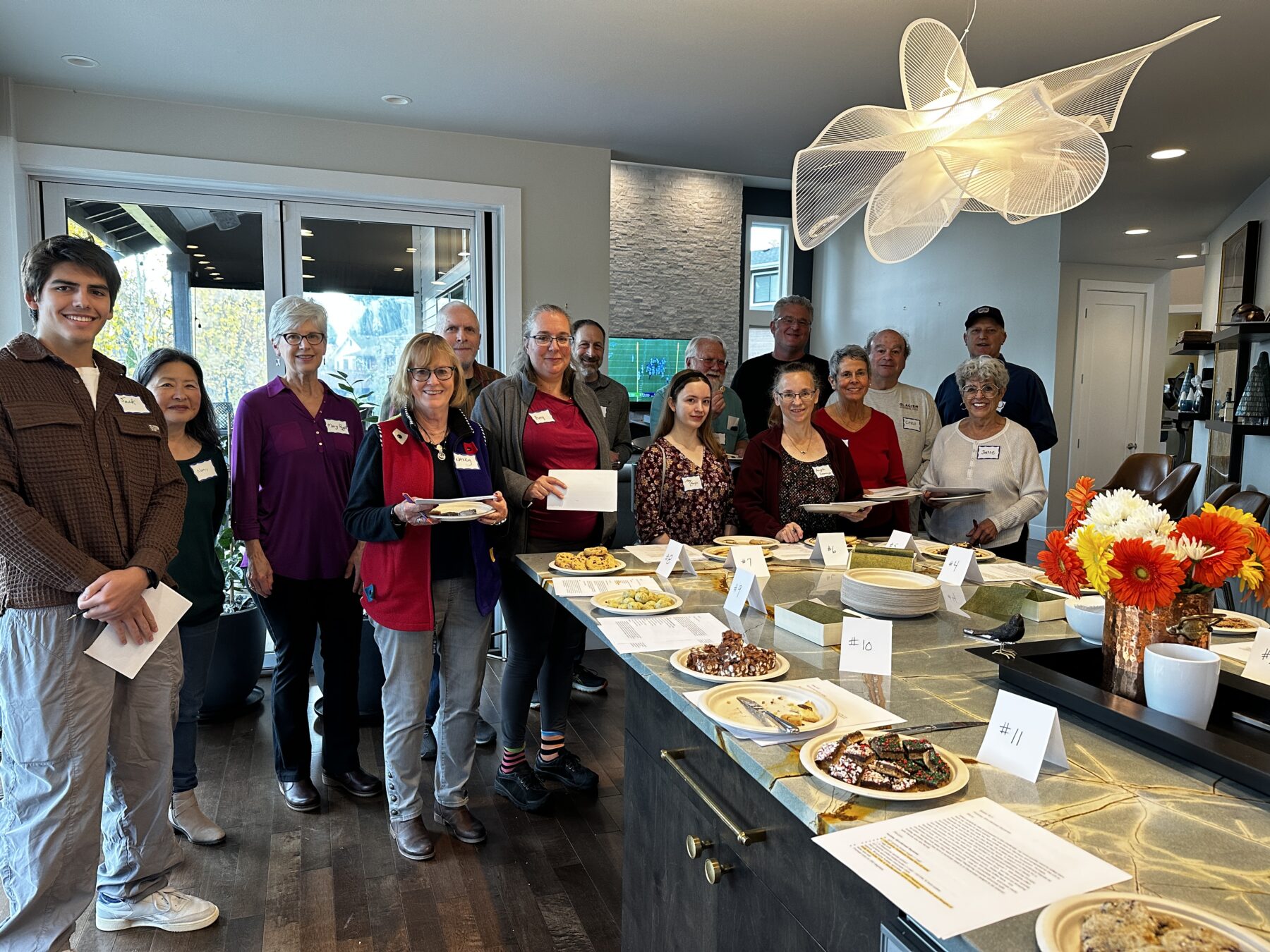
Leave a Reply
Which Formula To Choose (3)
Just getting started, here’s some info on our different formula options! We’re an equal leavening opportunity organization. Whether you’d like to use yeast, sourdough starter, or a combination of both, we’ve got just the right bread formula for you. Below is a quick description of the three available options. Click on any of the titles go directly to the page for downloading the formula.
The Modern – Yeast Only
The Modern Formula is the best formula for new bakers. Even experienced bakers find this formula’s predictability and overall loaf performance a winner. The Modern uses instant yeast for leavening, typically more active than a natural levain starter (sourdough). Short on time, although good bread is always a time investment, of the three, this is the quickest of them all.
The Classic – Hybrid
The Classic Formula uses a combination of natural sourdough starter for flavor and instant yeast for reliable performance. Use this formula if you have an existing active sourdough starter but want to add a pixie dust of instant yeast as leavening “insurance”. This formula gives you both great flavor and beautiful loft.
The Purist – Sourdough
The Purist Formula uses a natural sourdough starter for leavening. This formula is best for our most experienced bakers. It has been optimized to reduce any sour notes, but your own sweet efforts may still contribute some natural sourness.
Great question, the new classic formula has received mixed reviews and part of this has to do with some formulas that needed additional tweaking. Thanks to your inquiry and the feedback I re-tested with revised numbers yesterday. The test was very successful, but it is not yet published. Later this week we will get a new “trial” posted to the website and I’ll make sure to alert all. Many of our bakers love the current Classic, and I anticipate that it will remain an option into the future. You can use that with confidence.
I’m just curious about the new classic formula recipe and how it’s been received? I’m comfortable and have good results with the original formula and feel reluctant to change. Less sticky dough sounds good but my loaves already weigh more more than it says, more flour sounds like even more weight. Thoughts?
Leave a Reply
Shoot, your schedule suddenly opened up and you could have baked bread! You still can!
All our loaves begin with a pre-ferment. Typically, an 8-10 hour pre-game element brings delicious flavor to our loaves. But, if you didn’t plan to bake bread, is there a way to complete a one-day process? Yes, our modern formula uses a poolish, vs. a levain (sourdough). A poolish is simply a preferment made with flour, water, and conventional yeast. And, if you are in a pinch for time, as in you want to do a same-day bake, you can simply double the yeast in the pre-ferment.
Come Again: Simply follow the instructions on the formula/recipe for the poolish but double the yeast. That’s it. The same day, pre-ferment will be ready to go in 4 hours.
Fresh whole grain bread, start to finish, in a day!
Leave a Reply
The Modern – 3.0 Trial – Easier To Handle
Available for you to try immediately our new Modern formula in a less sticky, easier-to-manage recipe. When you open this formula you’ll see that there is a little more flour used and a little less porridge. Please, as always, weigh all ingredients to the exact proportions. This is an excel format and you can scale the recipe to as many loaves as you normally produce.
We’re calling this a “trial”. And your feedback is valuable. After we’ve collected and made any additional tweaks we’ll make similar modifications to the Classic and the Purist.
If you choose to try it out, please let us know how it goes via this feedback form.
